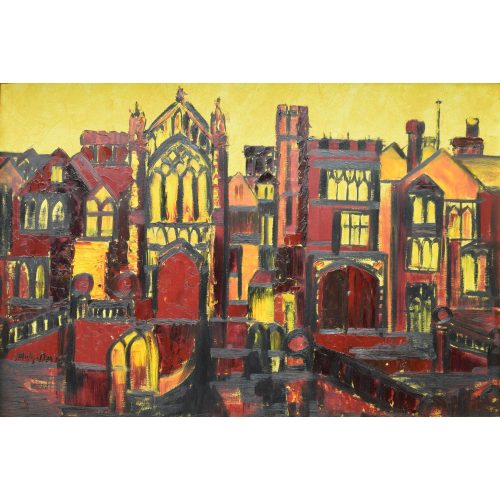-
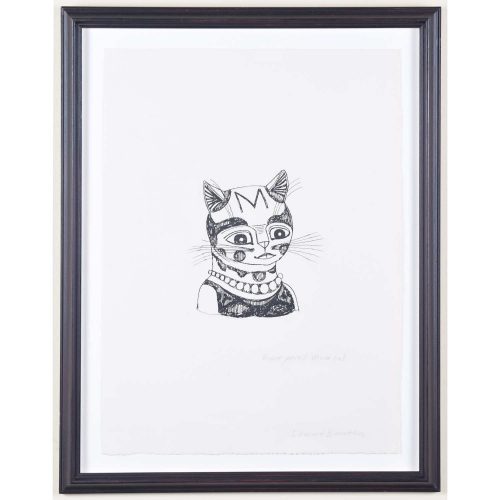
Edward Bawden (1903-1989)
House Proud Mum Cat
Pen and ink 38 x 27 cm Signed and inscribed lower right. Bawden developed a love of cats at a young age, copying Louis Wain's cat pictures. In his later years, his drawings of cats became yet more frequent; his cat Emma featured in much of his work. In an interview with House and Garden in 1987 he said: "No cat will suffer being lifted up and dropped into an empty space intended for her to occupy; that procedure led inevitably to Emma, tail up, walking away at once, so I had to wait patiently until Emma had enjoyed a good meal of Coley and was ready to choose her daily sleeping place, wherever it might be. I would then spring into action." Doubtless he found it easier to draw an imaginary cat, such as this one. For other cats - and other works - by Bawden, please click here. If you are interested, please email info@manningfineart.co.uk or call us on 07929 749056. -
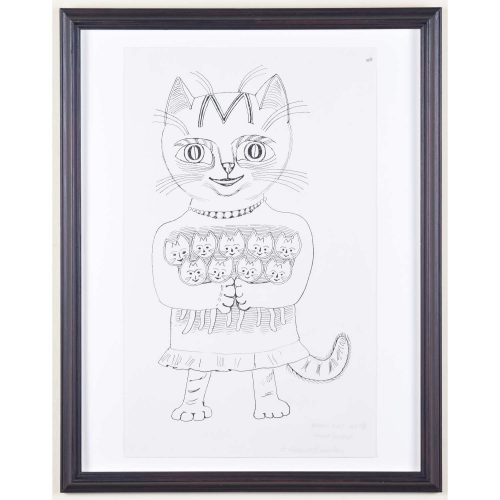
Edward Bawden (1903-1989)
Mum Cat with Nine Lives
Pen and ink 38 x 27 cm Signed and inscribed lower right. Bawden developed a love of cats at a young age, copying Louis Wain's cat pictures. In his later years, his drawings of cats became yet more frequent; his cat Emma featured in much of his work. In an interview with House and Garden in 1987 he said: "No cat will suffer being lifted up and dropped into an empty space intended for her to occupy; that procedure led inevitably to Emma, tail up, walking away at once, so I had to wait patiently until Emma had enjoyed a good meal of Coley and was ready to choose her daily sleeping place, wherever it might be. I would then spring into action." Doubtless he found it easier to draw an imaginary cat, such as this one. For other cats - and other works - by Bawden, please click here. If you are interested, please email info@manningfineart.co.uk or call us on 07929 749056. -
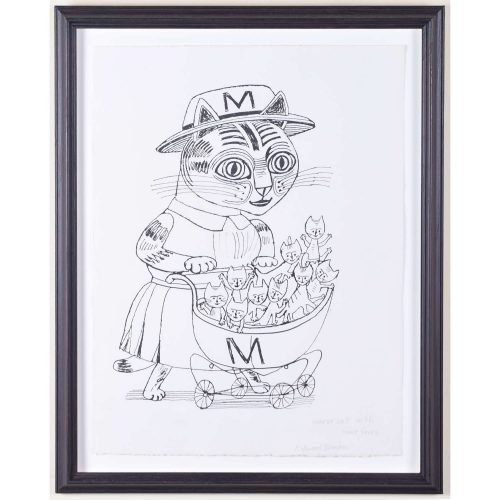
Edward Bawden (1903-1989)
Nurse Cat with Nine Lives
Pen and ink 38 x 27 cm Signed and inscribed lower right. Bawden developed a love of cats at a young age, copying Louis Wain's cat pictures. In his later years, his drawings of cats became yet more frequent; his cat Emma featured in much of his work. In an interview with House and Garden in 1987 he said: "No cat will suffer being lifted up and dropped into an empty space intended for her to occupy; that procedure led inevitably to Emma, tail up, walking away at once, so I had to wait patiently until Emma had enjoyed a good meal of Coley and was ready to choose her daily sleeping place, wherever it might be. I would then spring into action." Doubtless he found it easier to draw an imaginary cat, such as this one. For other cats - and other works - by Bawden, please click here. If you are interested, please email info@manningfineart.co.uk or call us on 07929 749056. -
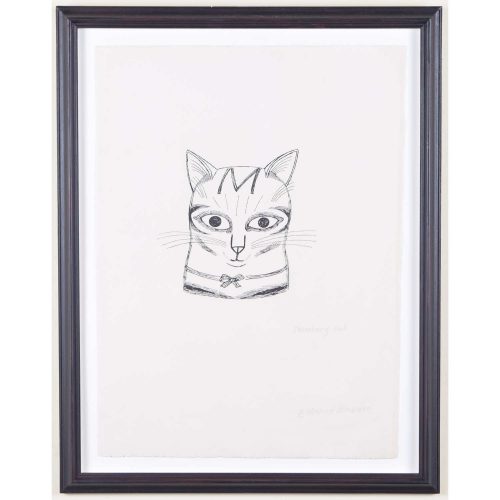
Edward Bawden (1903-1989)
Secretary Cat
Pen and ink 38 x 27 cm Signed and inscribed lower right. Bawden developed a love of cats at a young age, copying Louis Wain's cat pictures. In his later years, his drawings of cats became yet more frequent; his cat Emma featured in much of his work. In an interview with House and Garden in 1987 he said: "No cat will suffer being lifted up and dropped into an empty space intended for her to occupy; that procedure led inevitably to Emma, tail up, walking away at once, so I had to wait patiently until Emma had enjoyed a good meal of Coley and was ready to choose her daily sleeping place, wherever it might be. I would then spring into action." Doubtless he found it easier to draw an imaginary cat, such as this one. For other cats - and other works - by Bawden, please click here. If you are interested, please email info@manningfineart.co.uk or call us on 07929 749056. -
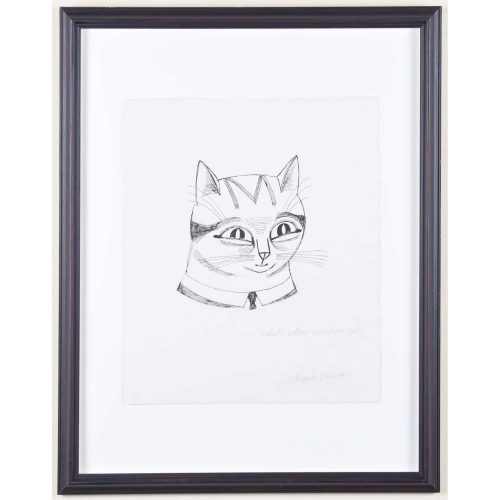
Edward Bawden (1903-1989)
White Collar Worker Cat
Pen and ink 27 x 23 cm Signed and inscribed lower right. Bawden developed a love of cats at a young age, copying Louis Wain's cat pictures. In his later years, his drawings of cats became yet more frequent; his cat Emma featured in much of his work. In an interview with House and Garden in 1987 he said: "No cat will suffer being lifted up and dropped into an empty space intended for her to occupy; that procedure led inevitably to Emma, tail up, walking away at once, so I had to wait patiently until Emma had enjoyed a good meal of Coley and was ready to choose her daily sleeping place, wherever it might be. I would then spring into action." Doubtless he found it easier to draw an imaginary cat, such as this one. For other cats - and other works - by Bawden, please click here. If you are interested, please email info@manningfineart.co.uk or call us on 07929 749056. -

Edward Bawden (1903 - 1989)
Aesop's Fables: Peacock and Magpie (1970)
Linocut print 63 x 75 cm Signed, numbered 11/50, and titled in pencil. A delightful print illustrating Aesop's fable of the Peacock and Magpie. In the fable, the birds are searching for a king, and the Peacock puts himself forward. The birds are about to make him king because of his charming plumage, but a Magpie asks the Peacock how he might defend the birds from predators. The Peacock has no answer. Aesop's moral is that those in power must be suited to the task, and not just vain pretenders. The artist's use of vibrant colour brings the tale to life. Edward Bawden was an English painter, illustrator and graphic artist, known for his prints, book covers, posters, and garden metalwork furniture. Bawden taught at the Royal College of Art, where he had been a student, worked as a commercial artist, and served as a war artist in World War II. He illustrated several books and painted various public murals, and his work and career are often associated with that of his contemporary, Eric Ravilious. Condition: generally very good; small stain to extremity that will be hidden under mount. If you’d like to know more, please email info@manningfineart.co.uk or call us on 07929 749056. -
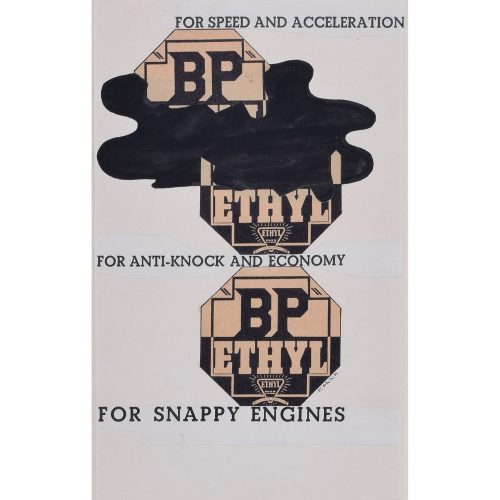
Edward McKnight Kauffer (1890-1954)
Original artwork ‘BP Ethyl for Snappy Engines' (1934)
Signed Pen, ink and collage 27x17cm (16.6×6.6 inches) Framed in a hand-finished black frame. Provenance: Sotheby's, sale of the Shell Archive 10 September 2003 lot 49. If you are interested email info@manningfineart.co.ukor call us on 07929 749056. -
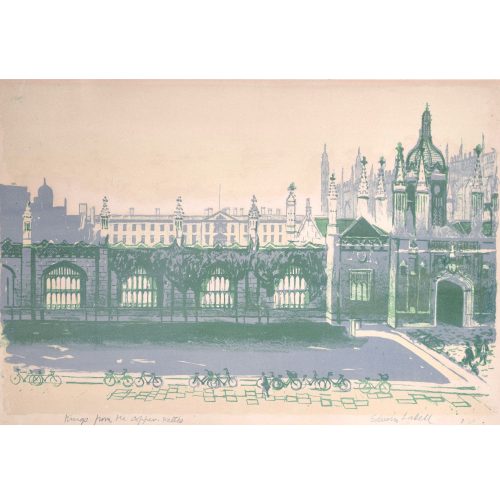
Edwin La Dell (1914-1970) King's College from the Copper Kettle, Cambridge
Signed in pencil and titled 32x48cm A copy of this print is in the Government Art Collection. Lithograph Born in Coventry, La Dell's father was a Sheffield-born bookbinder. After study at Sheffield School of Art, he was the winner of a scholarship to the Royal College of Art where the head of print making was John Nash (from 1934 to 1940). La Dell became head of lithography there from 1948 until his death. During the war he was an official war artist and a camofleur, but he is probably best known for his lithographs of Oxford and Cambridge that he published himself, together with those he published for the School Prints scheme and Lyons Tea Rooms. His works are widely held in the public collections, including the Royal Academy and the Government Art Collection, the latter having a copy of this print. If you are interested email info@manningfineart.co.uk or call us on 07929 749056. Condition: In conservation mount, some age toning to print as visible in photograph. -

Edwin La Dell (1914-1970) King's Parade, Cambridge
Signed in pencil and titled 35x47cm A copy of this print is in the Government Art Collection. Lithograph Born in Coventry, La Dell's father was a Sheffield-born bookbinder. After study at Sheffield School of Art, he was the winner of a scholarship to the Royal College of Art where the head of print making was John Nash (from 1934 to 1940). La Dell became head of lithography there from 1948 until his death. During the war he was an official war artist and a camofleur, but he is probably best known for his lithographs of Oxford and Cambridge that he published himself, together with those he published for the School Prints scheme and Lyons Tea Rooms. His works are widely held in the public collections, including the Royal Academy and the Government Art Collection, the latter having a copy of this print. If you are interested email info@manningfineart.co.uk or call us on 07929 749056. Condition: In conservation mount, some age toning to print as visible in photograph. -
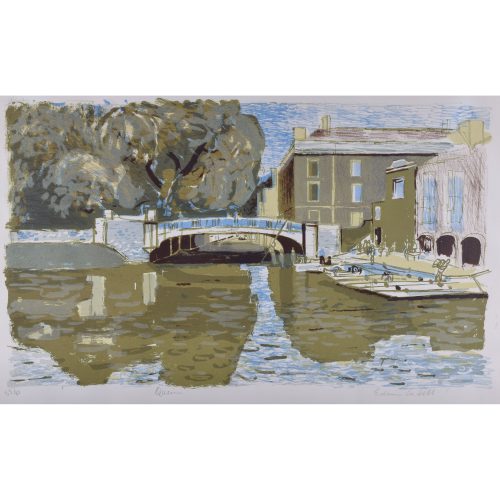
Edwin La Dell
Queens' College, Cambridge
Lithograph Signed in pencil and numbered 33/50 21x46.5cm A copy of this print is in the Government Art Collection. Click here for biographical details and other works by the artist. If you are interested email info@manningfineart.co.uk or call us on 07929 749056. -

Walter Hoyle (1922 - 2000)
Emmanuel College, Cambridge (Cambridge Series 1956 - 66)
Linocut 55 x 43 cm Signed and inscribed A/P in pencil. Hoyle's view of Emmanuel's Front Court bleaches the gold of the chapel's Ketton Stone into an icy blue, and situates it beneath a tempestuous yellow sky. Hoyle trained at Beckenham School of Art and the Royal College of Art. At the latter he was strongly influenced by Edward Bawden, one of Britain’s greatest linocut printers. Bawden had been commissioned by the 1951 Festival of Britain to produce a mural for the South Bank, and chose Hoyle to assist on account of his great talent. Hoyle moved to Great Bardfield in Essex, becoming a part of the Great Bardfield group of artists; diverse in style, they created figurative work, in stark contrast to the abstract art of the St Ives artists at the opposite end of the country. Hoyle taught at St Martin’s School of Art from 1951-60, the Central School of Arts and Crafts from 1960-64, and the Cambridge School of Art from 1964-1985, during which time he launched Cambridge Print Editions. His work is held in the collections of the Tate Gallery, the Victoria and Albert Museum, The British Museum, Kettle’s Garden and the Fry Art Gallery. Provenance: family of the artist. Condition: generally very good; a few handling marks and areas of discolouration to extreme margins, extraneous ink to right hand side, and a very small brown spot to very top right beyond the blue sky. If you are interested, please email info@manningfineart.co.uk or call us on 07929 749056. Click here for other views of Emmanuel College, Cambridge. -
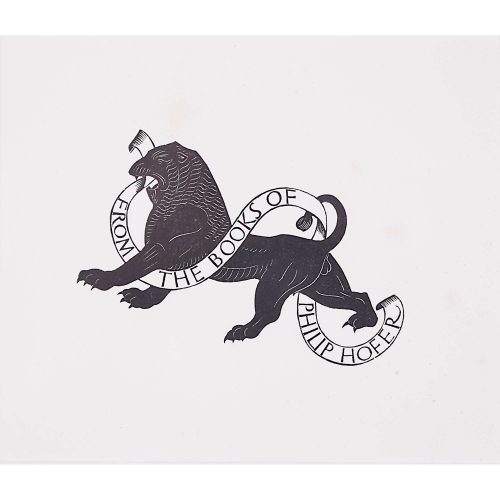
Eric Gill
From the Books of Philip Hofer Woodblock Print
Published Hague & Gill 1934 in an unnumbered edition of 300 23x21cm Following Chichester Technical and Art School, Gill moved to London in 1900 to train with the ecclesiastical architects W D Caroe. Finding architecture somewhat pedestrian he took stonemasonry lessons at Westminster Technical Institute and calligraphy lessons at the Central School of Arts and Crafts, coming under the influence of Edward Johnson, the designer of the London Underground's own typeface. In 1903 he ceased his attempts to become an architect, instead becoming a monumental mason, letter-cutter and calligrapher. Based in Ditchling, he began direct carving of stone figures, the semi-abstract figures taking their influence from mediaeval statuary, mixed with influences from Classical statuary from the Greeks and Romans, with a little post-Impressionism added in. With major commissions from Westminster Cathedral for its Stations of the Cross (1914), a series of War Memorials including the Grade II* memorial in Trumpington, and three of the sculptures for Charles Holden's 1928 headquarters of London Underground at 55 Broadway, St James's, and a series of sculptures for the new 1932 Broadcasting House. The list continues. Never one to rest on his laurels, he was at the same time engaged in typographical adventures. He had collaborated with Edward Johnson on the latter's initial thoughts on his London Transport typeface, but in 1925 designed Perpetua on his own, and Gill Sans between 1927-30. For the Golden Cockerel Press he created, in 1929, a bolder typeface to complement wood engravings. And of course Gill was publishing decorated books. His 1929 Canterbury Tales was an epic work, with a whole series of beautiful wood engravings such as this one. The present print is from the 1934 edition for Faber & Faber ('Engravings 1928-1933 by Eric Gill') he printed with his son-in-law, Rene Hague, produced with the original engraved wood blocks. Philip Hofer was a curator and collector, and commissioned this fine Ex Libris plate from Gill. If you are interested email info@manningfineart.co.uk or call us on 07929 749056. Condition: Generally very good condition. -
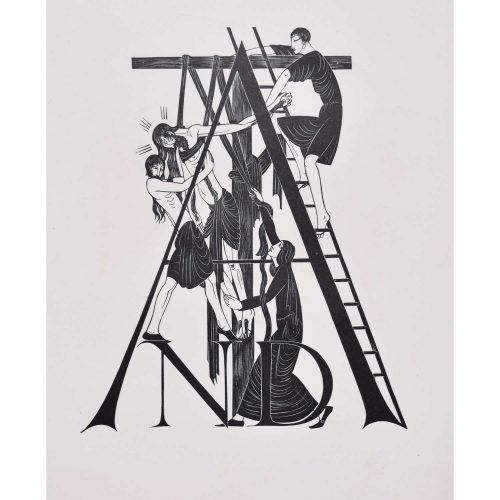
Eric Gill (1882-1940) The Deposition from the Cross
Woodblock Print Published Hague & Gill 1934 23x21cm Christ's body is taken down from the Cross, Mary assists by holding the ropes, and two men - Joseph of Arimathea and Nicodemus climb the ladder - one of the instruments of the passion. Click here for biographical details and other prints by Gill. If you are interested email info@manningfineart.co.uk or call us on 07929 749056. -
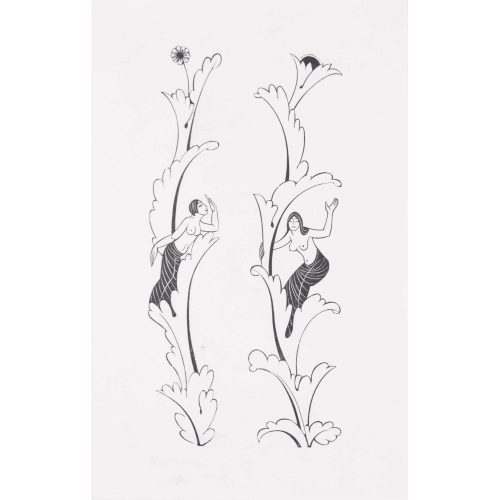
Eric Gill (1882-1940) Canterbury Tales Border - Two nudes i
Woodblock Print Published Hague & Gill 1934 23x21cm Condition: very good Click here for biographical details and other prints by Gill. If you are interested email info@manningfineart.co.uk or call us on 07929 749056. -
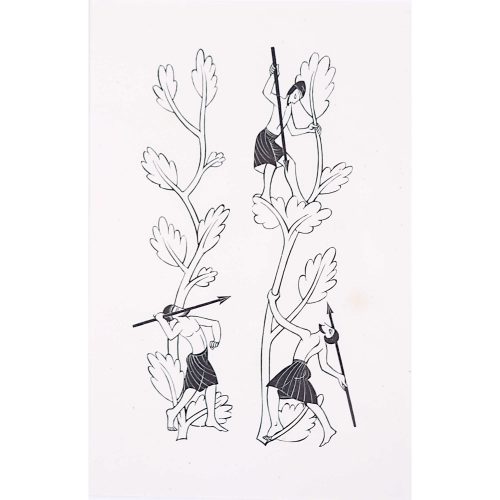
Eric Gill
Border for The Canterbury Tales (1929) - Three Men with Spears
Woodblock Print Published Hague & Gill 1934 in an unnumbered edition of 300 23x21cm Following Chichester Technical and Art School, Gill moved to London in 1900 to train with the ecclesiastical architects W D Caroe. Finding architecture somewhat pedestrian he took stonemasonry lessons at Westminster Technical Institute and calligraphy lessons at the Central School of Arts and Crafts, coming under the influence of Edward Johnson, the designer of the London Underground's own typeface. In 1903 he ceased his attempts to become an architect, instead becoming a monumental mason, letter-cutter and calligrapher. Based in Ditchling, he began direct carving of stone figures, the semi-abstract figures taking their influence from mediaeval statuary, mixed with influences from Classical statuary from the Greeks and Romans, with a little post-Impressionism added in. With major commissions from Westminster Cathedral for its Stations of the Cross (1914), a series of War Memorials including the Grade II* memorial in Trumpington, and three of the sculptures for Charles Holden's 1928 headquarters of London Underground at 55 Broadway, St James's, and a series of sculptures for the new 1932 Broadcasting House. The list continues. Never one to rest on his laurels, he was at the same time engaged in typographical adventures. He had collaborated with Edward Johnson on the latter's initial thoughts on his London Transport typeface, but in 1925 designed Perpetua on his own, and Gill Sans between 1927-30. For the Golden Cockerel Press he created, in 1929, a bolder typeface to complement wood engravings. And of course Gill was publishing decorated books. His 1929 Canterbury Tales was an epic work, with a whole series of beautiful wood engravings such as this one. The present print is from the 1934 edition for Faber & Faber ('Engravings 1928-1933 by Eric Gill') he printed with his son-in-law, Rene Hague, produced with the original engraved wood blocks. If you are interested email info@manningfineart.co.uk or call us on 07929 749056. Condition: Generally very good condition. -

Eric Gill
Initial Letter 'H' for The Canterbury Tales (1929) - The Doctor's Tale
Woodblock Print Published Hague & Gill 1934 in an unnumbered edition of 300 23x21cm Following Chichester Technical and Art School, Gill moved to London in 1900 to train with the ecclesiastical architects W D Caroe. Finding architecture somewhat pedestrian he took stonemasonry lessons at Westminster Technical Institute and calligraphy lessons at the Central School of Arts and Crafts, coming under the influence of Edward Johnson, the designer of the London Underground's own typeface. In 1903 he ceased his attempts to become an architect, instead becoming a monumental mason, letter-cutter and calligrapher. Based in Ditchling, he began direct carving of stone figures, the semi-abstract figures taking their influence from mediaeval statuary, mixed with influences from Classical statuary from the Greeks and Romans, with a little post-Impressionism added in. With major commissions from Westminster Cathedral for its Stations of the Cross (1914), a series of War Memorials including the Grade II* memorial in Trumpington, and three of the sculptures for Charles Holden's 1928 headquarters of London Underground at 55 Broadway, St James's, and a series of sculptures for the new 1932 Broadcasting House. The list continues. Never one to rest on his laurels, he was at the same time engaged in typographical adventures. He had collaborated with Edward Johnson on the latter's initial thoughts on his London Transport typeface, but in 1925 designed Perpetua on his own, and Gill Sans between 1927-30. For the Golden Cockerel Press he created, in 1929, a bolder typeface to complement wood engravings. And of course Gill was publishing decorated books. His 1929 Canterbury Tales was an epic work, with a whole series of beautiful wood engravings such as this one. The present print is from the 1934 edition for Faber & Faber ('Engravings 1928-1933 by Eric Gill') he printed with his son-in-law, Rene Hague, produced with the original engraved wood blocks. In Chaucer's Tales, the Summoner's Tale tells the story of the man who summonsed people to the ecclesiastical courts. It satirises the friar, considering him to be corrupt. Philip Hofer was a curator and collector, and commissioned this fine Ex Libris plate from Gill. If you are interested email info@manningfineart.co.uk or call us on 07929 749056. Condition: Generally very good condition. -
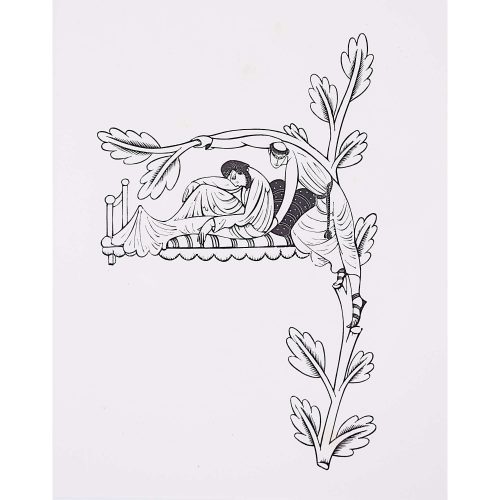
Eric Gill
Canterbury Tales The Summoner's Tale
Woodblock Print Published Hague & Gill 1934 in an unnumbered edition of 300 23x21cm Following Chichester Technical and Art School, Gill moved to London in 1900 to train with the ecclesiastical architects W D Caroe. Finding architecture somewhat pedestrian he took stonemasonry lessons at Westminster Technical Institute and calligraphy lessons at the Central School of Arts and Crafts, coming under the influence of Edward Johnson, the designer of the London Underground's own typeface. In 1903 he ceased his attempts to become an architect, instead becoming a monumental mason, letter-cutter and calligrapher. Based in Ditchling, he began direct carving of stone figures, the semi-abstract figures taking their influence from mediaeval statuary, mixed with influences from Classical statuary from the Greeks and Romans, with a little post-Impressionism added in. With major commissions from Westminster Cathedral for its Stations of the Cross (1914), a series of War Memorials including the Grade II* memorial in Trumpington, and three of the sculptures for Charles Holden's 1928 headquarters of London Underground at 55 Broadway, St James's, and a series of sculptures for the new 1932 Broadcasting House. The list continues. Never one to rest on his laurels, he was at the same time engaged in typographical adventures. He had collaborated with Edward Johnson on the latter's initial thoughts on his London Transport typeface, but in 1925 designed Perpetua on his own, and Gill Sans between 1927-30. For the Golden Cockerel Press he created, in 1929, a bolder typeface to complement wood engravings. And of course Gill was publishing decorated books. His 1929 Canterbury Tales was an epic work, with a whole series of beautiful wood engravings such as this one. The present print is from the 1934 edition for Faber & Faber ('Engravings 1928-1933 by Eric Gill') he printed with his son-in-law, Rene Hague, produced with the original engraved wood blocks. In Chaucer's Tales, the Summoner's Tale tells the story of the man who summonsed people to the ecclesiastical courts. It satirises the friar, considering him to be corrupt. Philip Hofer was a curator and collector, and commissioned this fine Ex Libris plate from Gill. If you are interested email info@manningfineart.co.uk or call us on 07929 749056. Condition: Generally very good condition. -

Ethel Louise Rawlins (1880 – 1940)
A Garden Below the South Downs
Oil on canvas51 x 61 cmSigned lower right.Rawlins was a painter who studied at the Slade School of Fine Art and in Newlyn, Cornwall. She settled in Sussex in the early 1920s, and often painted the rolling hills of the Sussex landscape. Here, blue hills and a grey sky serve as the background for an extensive garden complete with stone urns, flowers, and slanting shadows created by the late afternoon sun. -
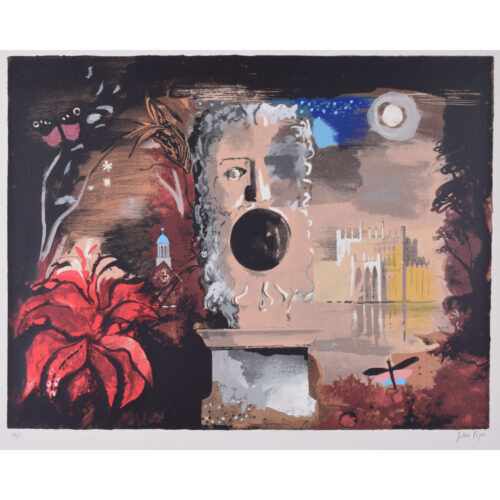
John Piper (1903 - 1992)
Façade (1987)
Lithograph 45 x 60 cm Numbered 96/108 lower left and signed lower right, both in pencil. Printed by Piper and the screenprinter Chris Prater in 1987 after the original designs from 1942. 'Façade' was a sequence of poems written by the English poet Edith Sitwell. They were set to music by William Walton in 1922, four years after they were first written. 'Façade' premiered in 1923 in London, and was praised for its experimental modernist style. The choreographer Frederick Ashton made Façade into a ballet in 1931; Sitwell did not wish her poems to be included, but Walton's orchestral arrangements were used. John Piper was commissioned as set designer for a 1942 performance of Facade in 1942. This lithograph is the design for the performance's curtain; the poetry and music of the performance were played behind the curtain, unseen by the audience. The Gothic house to the right was inspired by Eaton Hall in Cheshire, and we also see a folly, lake, and wood typical of an English country house. The moon, butterfly, and dragonfly lend themselves to the scene's dreamlike aspects, and the mask in the centre of the design highlights the collaborative nature of Façade - a salute to poetry, music, art, and even architecture. John Piper CH was an English painter, printmaker, and designer of stained-glass windows. His work often focused on the British landscape, especially churches and monuments, and included tapestry designs, book jackets, screen-prints, photography, fabrics and ceramics. Condition: very good. If you are interested, please email info@manningfineart.co.uk or call us on 07929 749056. Click here for other works by John Piper. -
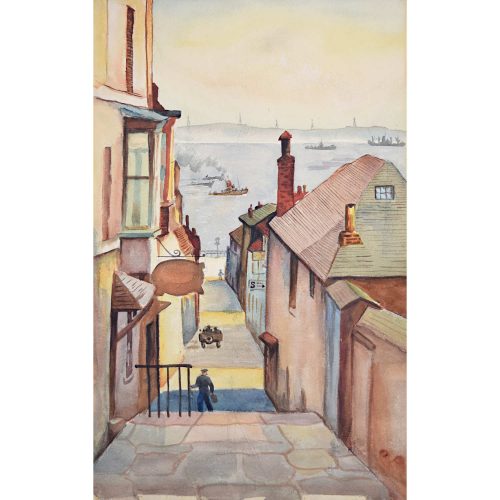
Falmouth, 1944 (unknown Modern British Artist)
Watercolour 46 x 30cm An evocative painting of Falmouth, the Cornish town shaped by its relationship to the sea. The artist leads us from the warm tones of the stone flags and empty buildings down towards a grey sea and a gently smouldering sky. Ships move in to the port, and a unit of pylons, starkly silhouetted, looks out over the bay. Condition: excellent. If you’d like to know more, please email info@manningfineart.co.uk or call us on 07929 749056. -
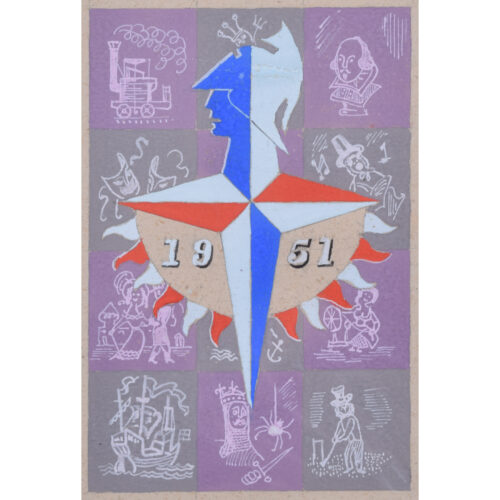
Peter J Wright after Abram Games (1914 - 1996)
Festival of Britain Logo (1951)
Gouache 21 x 13 cm A gouache painting of Abram Games' fantastic Art Deco Modern design for the logo advertising the Festival of Britain. Games' design, called the Festival Star, includes a modernist Britannia in profile with bunting below, all set on the four points of the compass and in the Union Jack colours of red, white, and blue. Games was one of twelve artists invited to submit designs to the Arts Council and the Council of Industrial Design in 1948. The Festival of Britain was a national exhibition and fair that reached millions of visitors throughout the United Kingdom in the summer of 1951. It was devised as a celebration of a hundred years since the Great Exhibition of 1851, but focused entirely on Britain and its achievements rather than adopting the international outlook of the Great Exhibition. The Festival's purpose was to highlight and celebrate how far Britain had come in the wake of the Second World War's devastation. Abram Games OBE RDI was a celebrated British graphic artist. His parents were Eastern European Jews and changed their family name from Gamse to Games after moving to Britain. Games studied at Saint Martin's School of Art in London but left after two terms; aged 21, he won a poster competition for the London County Council and then began to work as a freelance poster designer. In 1937 the journal Art and Industry featured him in an article and this resulted inseveral high-profile graphic design commissions from the General Post Office, London Transport, Royal Dutch Shell, and more. He also designed stamps for the Israeli Post Office, covers for The Jewish Chronicle and synagogue prayer book prints, and designed several posters promoting Jewish organisations and initiatives. Condition: generally very good. If you are interested, please email info@manningfineart.co.uk or call us on 07929 749056. Click here for other Modern British design. -
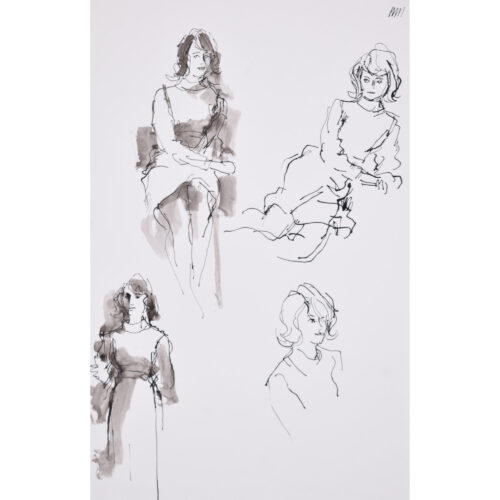
Peter Collins ARCA (1923 - 2001)
Figure Studies
Ink and wash 44 x 28 cm Provenance: the artist's studio sale. Four characterful and intimate clothed studies of a model with voluminous 1960s hair. Collins' first job was in the commercial studio of an advertising agency. World War II interrupted his career and he joined the Royal Artillery, teaching painting and drawing in the Education Corps - whilst simultaneously teaching at St Martin's School of Art, part time. Following the war, Collins studied at the Royal College of Art, winning a scholarship. He then worked as a commercial artist, producing some well-known posters for clients including British Railways and British European Airways. He was the Art Director at Odhams Press and spent time designing for both ICI and Shell. With his wife Georgette, he created the 'Bacombe Galleries' in Sussex, converting a group of buildings into a gallery space. In 1975 they developed the Stanley Studios in Chelsea, which were scheduled for redevelopment, into a combined artists' studio and residence. Moving into the Stanley Studios allowed the Collinses to immerse themselves in Chelsea's art scene, and they proceeded to fill the studios with art, antiques, sculpture, and other curios. Condition: generally very good. If you are interested, please email info@manningfineart.co.uk or call us on 07929 749056. Click here for other works by Peter Collins. -
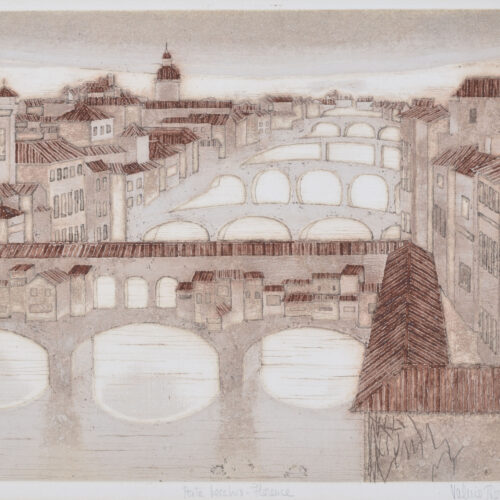
Valerie Thornton (1931 - 1991)
Ponte Vecchio, Florence (1972)
Etching and aquatint 33 x 20 cm Numbered 1/60 lower left, titled below, and signed and dated lower right, all in pencil. Here, Thornton muses on the dramatic differences in tone and texture between the water of the River Arno, the smooth paleness of the Ponte Vecchio, and the dark terracotta of the city's roofs. Her work is deeply concerned with material, and many of her etchings focus on eroded stone, emotive landscapes, and weathered architecture. Valerie Thornton was a British etcher and printmaker. She was born in London, but was evacuated to Canada with her two brothers during World War II. She returned to London in 1944 and studied at the Byam Shaw School of Art in 1949. From 1950 to 1953 Thornton studied under P.F. Millard at the Regent Street Polytechnic, then spent eight months at Atelier 17 in Paris. In the early 1960s, she moved to New York and worked at Pratt Graphic Art Center. In 1955, she succeeded Howard Hodgkin as assistant art teacher at Charterhouse School and in 1965 she became a founding member of the Print Makers Council. In 1970 she became a Fellow of the Royal Society of Painters-Etchers and Engravers. Thornton was a member of The Regent Street Group (a group of nine artists who studied together at the Regent Street Polytechnic in the early 1950s). The group also included Susan Horsfield, Renate Meyer, Michael Lewis, Ken Symonds, Philip Le Bas, and Peter Riches. Thornton's work is included in a number of major public collections including the Victoria and Albert Museum, the British Museum, and the Tate. Thornton died in 1991 in Chelsworth, Suffolk. Condition: good; slight but even age toning. If you are interested, please email info@manningfineart.co.uk or call us on 07929 749056. Click here for other pictures of Italy. -
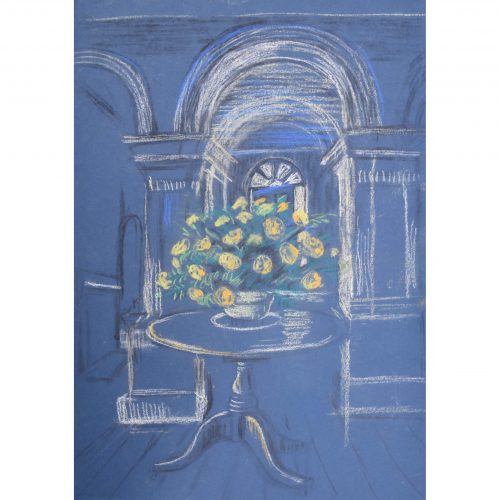
Hilary Hennes (née Hilary Miller) (1919 - 1993)
Flowers on a Table
Chalks 56 x 38 cm A chalk drawing depicting a vase of bright flowers on a table in a high-ceilinged room with elegant architectural features. Hilary Miller was born in London, where her father was a curator at the South London Art Gallery. She attended Blackheath High School and, from 1936 to 1940, studied at the Blackheath School of Art, and then for a further three years at the Royal College of Art. After graduating, she taught at the South East Sussex Technical College and in 1946 married the artist Hubert Hennes. The couple lived in Oxford, where they both held teaching posts at the Oxford School of Art. Between 1948 and 1967 Miller frequently exhibited paintings at the Royal Academy in London, and also illustrated a number of books on gardening and natural history, such as 'The Living World' and 'Boff's Book of Gardening'. Provenance: the artist's studio sale. Condition: generally very good. Drawing of a standing nude to the reverse (see photographs). If you are interested, please email info@manningfineart.co.uk or call us on 07929 749056. Click here for other works by the artist. -

Fredda Brilliant (1903-1999)
The Young Atlas
Patinated bronze 52.5 x 41.5 x 27.5 cm ; 16kg. On wooden base Fredda Brilliant was a Polish sculptor and actress, born in Łódź, Poland. She worked in a variety of media and is recognized as an accomplished sculptor, writer, actor, singer and script writer. Throughout her career she traveled extensively working in England, USA, Australia, India, Poland and Russia. Brilliant sculpted some of the greatest figures of her time including Jawaharlal Nehru, V.K. Krishna Menon, Indira Gandhi, U.S. President John F Kennedy, and Buckminster Fuller. She also sculpted her husband, the writer Herbert Marshall. Brilliant's most famous work is a bronze statue of Mahatma Gandhi which is the centerpiece of the park in Tavistock Square, London, UK. Condition: excellent. -
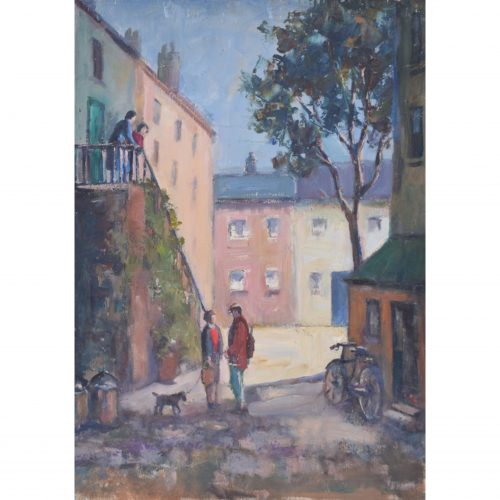
Angela Stones (1914 - 1995)
French Street Scene
Oil on board 56 x 41 cm A delightful mid-century oil painting. A couple and their dog meander down a cobbled French lane under a bright blue sky. Stones was educated at the Chelsea School of Art, and was a member of an artistic dynasty. Her mother Dorothy Bradshaw (1893-1983) studied under Jack Merriott – the artist famous for his British Rail posters, and her son, Christopher Assheton-Stones (1947-1999), was arguably the foremost pastel artist of his time. Provenance: the family of the artist. Condition: very good. If you’d like to know more, please email info@manningfineart.co.uk or call us on 07929 749056. -
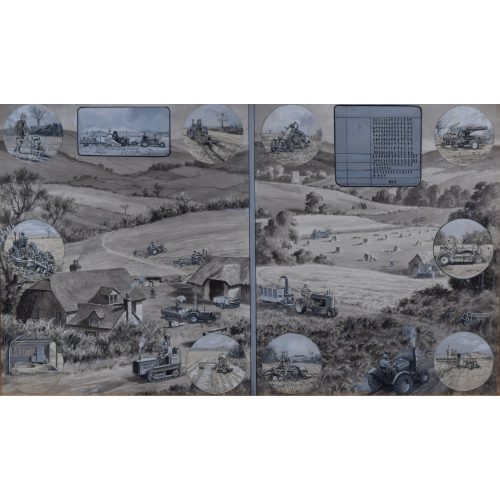
George Horace Davis (1888-1963) Design for publication probably in The Illustrated London News
Tractors and mechanisation Signed and dated 1947 Gouache, monochrome 17.25x29.75" Here the reduction in manpower as a result of the mechanisation of agriculture is celebrated in a typical work by Davis. A "special artist" for 'The Illustrated London News', he worked for it for forty years, the scope and detail of his work being without peer in the rest of the staff. Tractors are pictured in every possible role in agriculture; however the great advances made in the sixty years since then could not have been forseen. Born in Kensington, London, Davis was educated at Kensington Park College and then at Ealing School of Art, working subsequently as a freelance artist until the First World War intervened. He served with the Royal Flying Corps (subsequently the Royal Air Force) with distinction, and had a number of his paintings of aerial combat published in 'The Sphere.' In 1923 he commenced work with The Illustrated London News, for which he worked for the next forty years. His first drawing related to the use, in small boats, of wireless and was the first of many similar diagrammatic drawings designed to educate and inform readers of advances in science, warfare, technology or transport. Needless to say his attention to detail meant architectural drawings were another strength of his, drawings of 10 Downing Street and Westminster Abbey, for instance - and also architectural phantasies such as a proposed heliport at Charing Cross Station. During his career at The Illustrated London News he is estimated to have produced illustrations covering some 2,500 pages of the publication; each one requiring an informed understanding arising from careful research. He continued to work for it until his eighties and at the time of his death there was a supply of finished but as-yet-unpublished works. The sale at Christies in London of the archive of The Illustrated London News on 7 October 2014 included many works by Davis - a price of £16,875 being obtained for a series of seven drawings by him. -
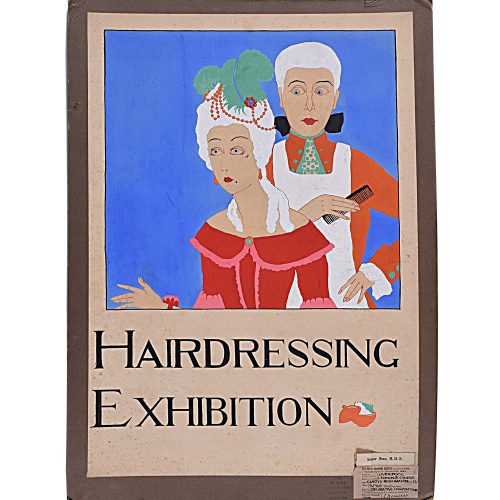
Gladys Williamson
Hairdressing Exhibition
Original Painted Design for Poster55x38cm
Gladys Williamson, a student at St Edmunds College, Liverpool was awarded a silver star for this decorative composition. The award is still attached in the bottom right corner of the design. If you are interested email info@manningfineart.co.uk or call us on 07929 749056. Condition: Generally good, some light spotting. Mounted to board by artist, with label to bottom right. -
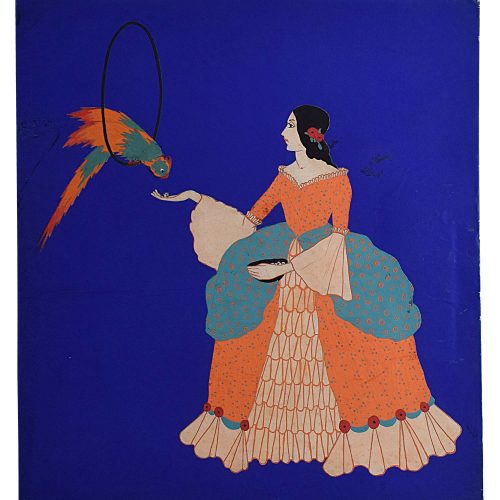
Gladys Williamson
Lady and Parrot
Original Painted Design for Poster Collage and Gouache43x38.5cm
If you are interested email info@manningfineart.co.uk or call us on 07929 749056. Condition: Generally very good, slight wear to blue background some spotting to rim of dress. -
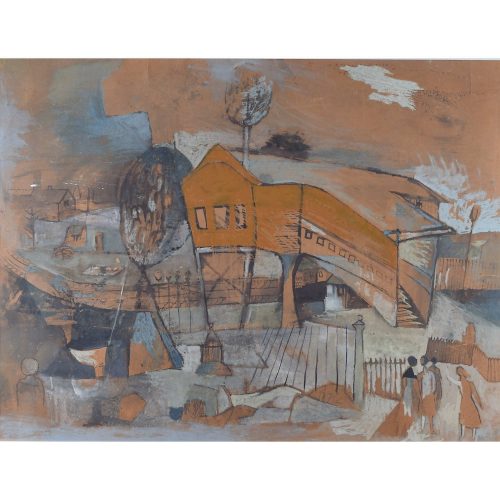
Gwyneth Johnstone (1915 - 2010)
The Railway Bridge
Mixed media 64 x 83 cm Signed lower left in paint, and monogrammed lower left in pencil. Provenance: the estate of the artist. Johnstone explores the possibilities of abstraction in this semi-delirious depiction of a railway bridge. Painted in tones of burnt umber, orange, grey, and black, the picture is populated by warped railings, bending trees, and staring onlookers, all of which centre around a railway line and bridge. Tanya Harrod described Johnstone's painting style a 'a hallucinogenic, haunting pastoral', and that is immensely evident in this picture. Johnstone was an English painter who worked mostly in oils and often depicted poignant modern landscapes. Her parents were the musician Nora Brownsford and the artist Augustus John. She studied at the Slade School of Fine Art, where she established lifelong friendships with fellow artists Mary Fedden and Virginia Parsons. After the Slade, Johnstone was taught academicised cubism by the painter André Lhote at the Académie de la Grande Chaumière in Paris. For a brief period in the early 1950s she took life classes with the surrealist artist Cecil Collins at the Central School of Arts and Crafts. -
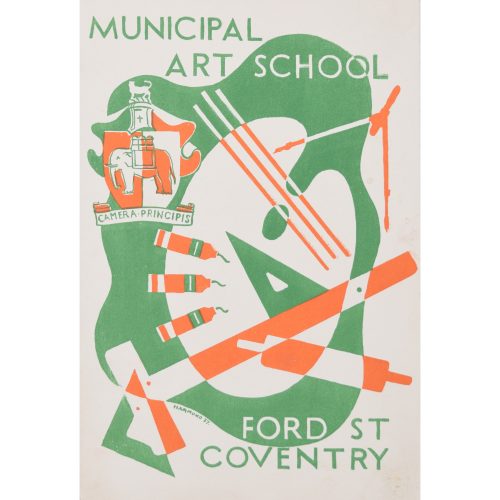
Hammond (British, fl. 1930s) Design for Municipal Art School Brochure
21.5x18 cm Lithograph drawn directly to stone, 1937 Sadly nothing is known of the life of the artist of this series of rather fine Art Deco designs we have listed. This is drawn directly onto the stone, a considerable skill in itself, and in just two colours in order to limit the cost of the lithography. If you are interested email info@manningfineart.co.uk or call us on 07929 749056. Condition: Generally very good. -
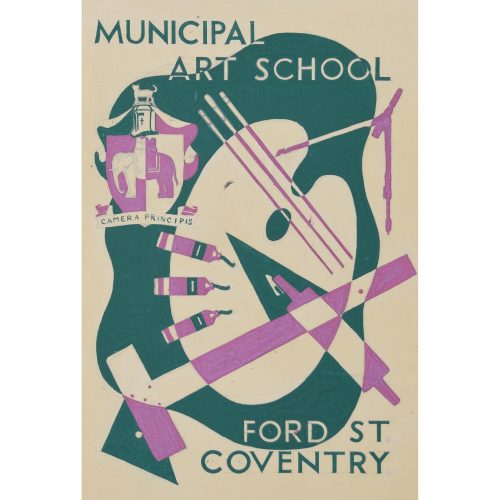
Hammond (British, fl. 1920s) Original artwork for brochure for Municipal Art School, Ford St, Coventry, England UK
21.5x14 cm Gouache, c. 1937 Sadly nothing is known of the life of the artist of thes series of rather fine Art Deco designs we have listed. If you are interested email info@manningfineart.co.uk or call us on 07929 749056. Condition: Generally very good. -
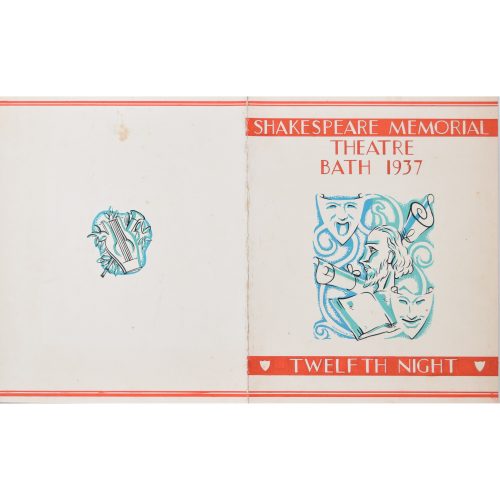
Hammond (British, fl. 1920s) Original artwork for Design for Shakespeare Twelfth Night programme to be held in Bath
26x21 cm Gouache, 1937 Sadly nothing is known of the life of the artist of thes series of rather fine Art Deco designs we have listed. If you are interested email info@manningfineart.co.uk or call us on 07929 749056. Condition: Generally good; small stain to reverse as illustrated in photograph; fold to centre as intended by artist. -
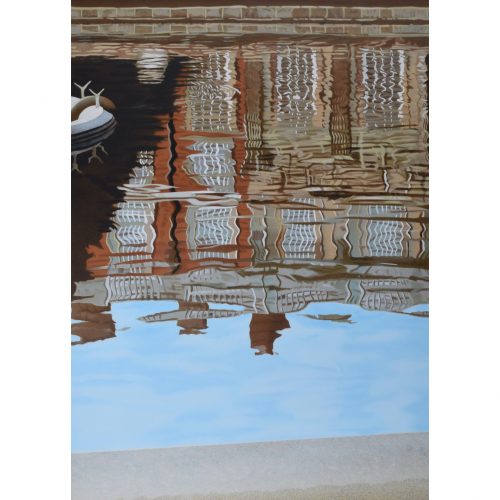
Brendan Neiland (b.1941) R.A. (Expelled)
Hampton Court (1984)
Screenprint 74 x 51 cm Signed, dated, titled, and numbered 152/250 in pencil. A print of one of Hampton Court's magnificent facades, reflected in its fountain. Reflected architecture is one of Neiland's most recurring themes. The Fountain Court was designed by Sir Christopher Wren; he began remodelled the palace in the baroque style for William III and Mary II in 1689. It held private and state apartments for both the King and Queen. Wren’s other works at Hampton Court Palace include the Lower Orangery and the grand colonnade in Clock Court, providing a grand entrance to the King's Apartments. The architectural historian Sir John Summerson described Fountain Court as 'Startling, as of simultaneous exposure to a great many eyes with raised eyebrows'. Brendan Neiland (born 23 October 1941 in Lichfield, Staffordshire) is an English artist best known for his paintings of reflections in modern city buildings. In 1992 he was elected to the Royal Academy (RA). Neiland is known for his interpretations of city life. His work is widely exhibited in major museums and galleries worldwide including, in Britain, the Victoria and Albert Museum, The Tate Gallery London, The Collections of the British Council and the Arts Council of Great Britain. He is represented by the Redfern Gallery and has had numerous shows internationally, including at the Galerie Belvedere in Singapore, who represent him in Singapore and the Far East. Condition: very good. If you’d like to know more, please email info@manningfineart.co.uk or call us on 07929 749056. -

Henry Cliffe (1919-1983) Abstract Harbour
Etching Mid 20th Century 13x19cm Click here for biographical details and other pictures by the artist. If you are interested email info@manningfineart.co.uk or call us on 07929 749056. Condition: Good. -
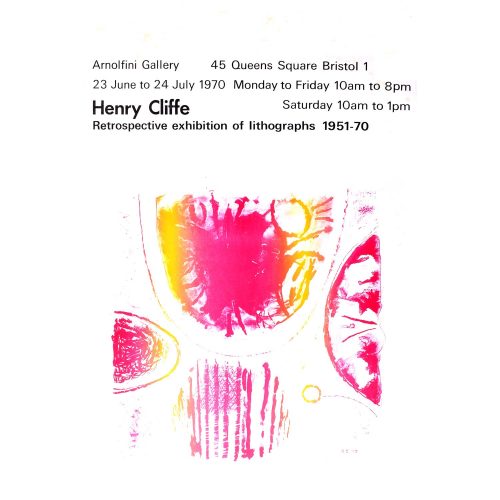
Henry Cliffe (1919-1983) Arnolfini Gallery Exhibition of Lithographs
Etching Mid 20th Century 76x50cm Click here for biographical details and other pictures by the artist. If you are interested email info@manningfineart.co.uk or call us on 07929 749056. Condition: Good, some faint spots at top. -
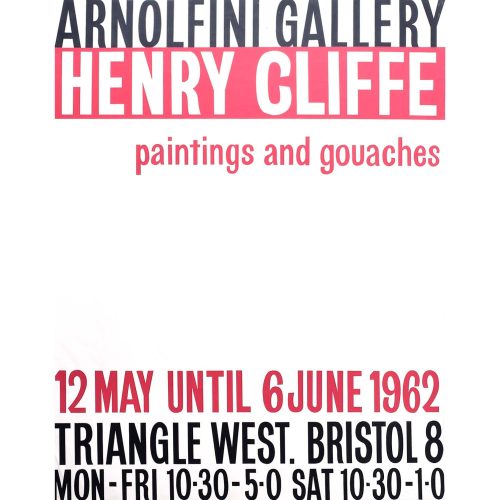
Henry Cliffe (1919-1983) Arnolfini Gallery Poster
Etching Mid 20th Century 63.5x51cm Click here for biographical details and other pictures by the artist. If you are interested email info@manningfineart.co.uk or call us on 07929 749056. Condition: Good, some faint spots at top. -
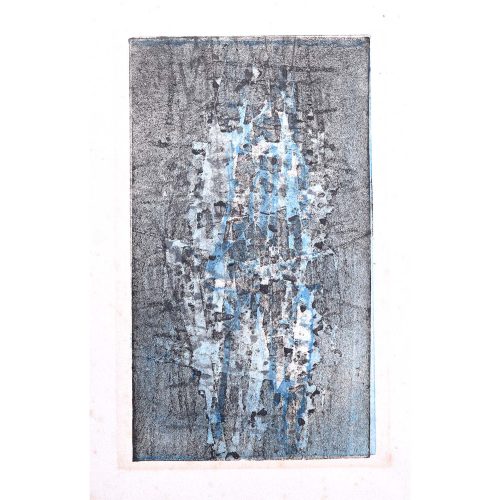
Henry Cliffe (1919-1983) Blue Figures
Etching Mid 20th Century 9.5x16.5cm Click here for biographical details and other pictures by the artist. If you are interested email info@manningfineart.co.uk or call us on 07929 749056. Condition: Good. -
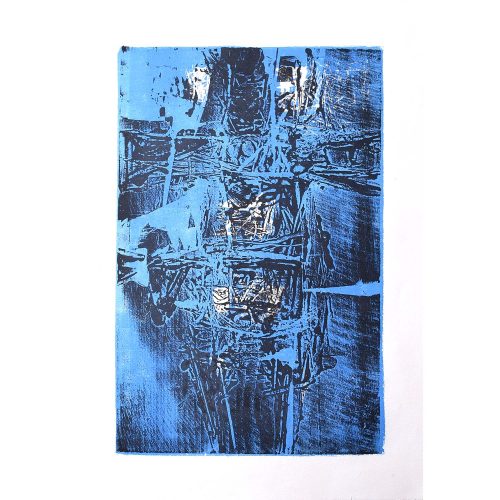
Henry Cliffe (1919-1983) Blue Standing Figure
Etching Mid 20th Century 46x30cm Click here for biographical details and other pictures by the artist. If you are interested email info@manningfineart.co.uk or call us on 07929 749056. Condition: Good. -

Henry Cliffe (1919-1983) Blue Standing Figure II
Etching Mid 20th Century 45.5x30cm Click here for biographical details and other pictures by the artist. If you are interested email info@manningfineart.co.uk or call us on 07929 749056. Condition: Good. -
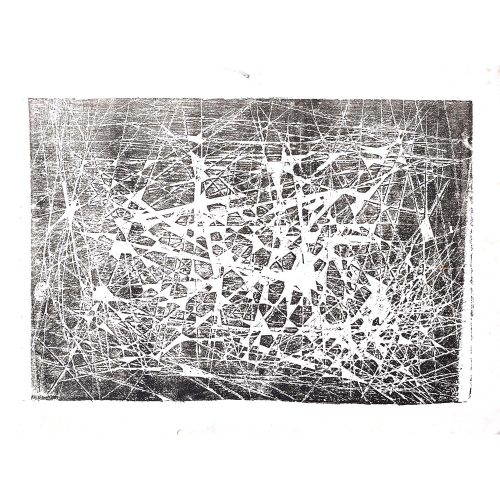
Henry Cliffe (1919-1983) Constellations I
Etching Mid 20th Century 9x16.5cm Click here for biographical details and other pictures by the artist. If you are interested email info@manningfineart.co.uk or call us on 07929 749056. Condition: Good. -

Henry Cliffe (1919-1983) Constellations II
Etching Mid 20th Century 16x24cm Click here for biographical details and other pictures by the artist. If you are interested email info@manningfineart.co.uk or call us on 07929 749056. Condition: Good. -
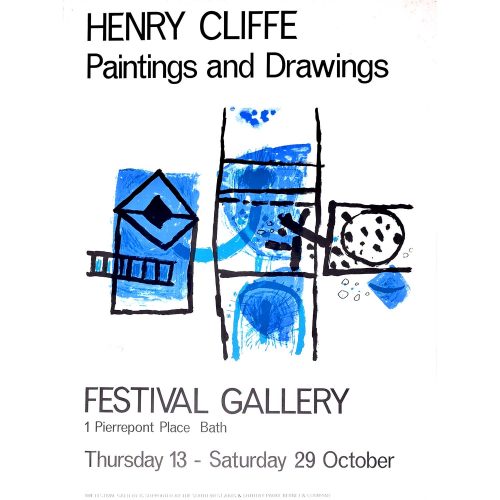
Henry Cliffe (1919-1983) Festival Gallery Poster
Etching Mid 20th Century 51x38cm Click here for biographical details and other pictures by the artist. If you are interested email info@manningfineart.co.uk or call us on 07929 749056. Condition: Good, some faint spotting round margins. -
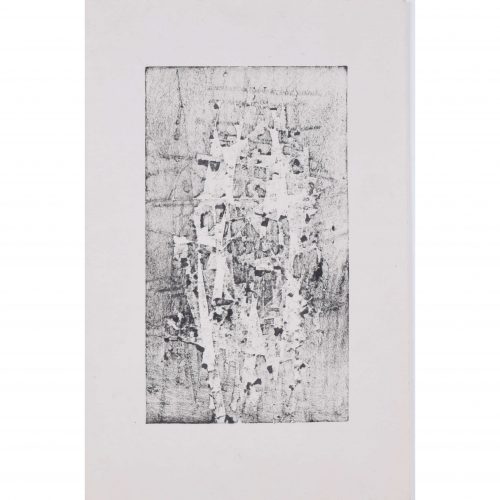
Henry Cliffe (1919-1983) Monochrome Figures
Etching 9.5 x 16.5 cm Condition: Good. If you are interested, please email info@manningfineart.co.uk or call us on 07929 749056. -
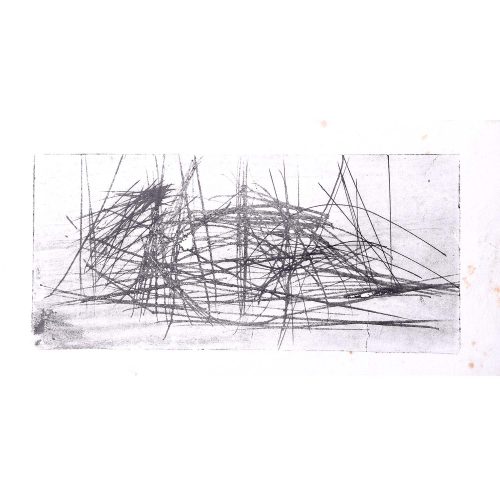
Henry Cliffe (1919-1983) Reclining Figure I
Etching Mid 20th Century 11x24cm Click here for biographical details and other pictures by the artist. If you are interested email info@manningfineart.co.uk or call us on 07929 749056. Condition: Good. -
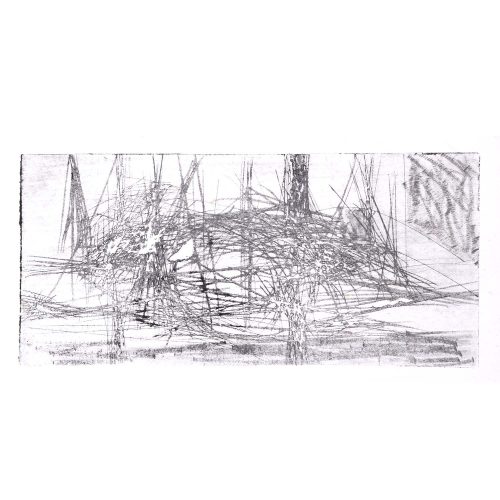
Henry Cliffe (1919-1983) Reclining Figure II
Etching Mid 20th Century 11x24cm Click here for biographical details and other pictures by the artist. If you are interested email info@manningfineart.co.uk or call us on 07929 749056. Condition: Good. -
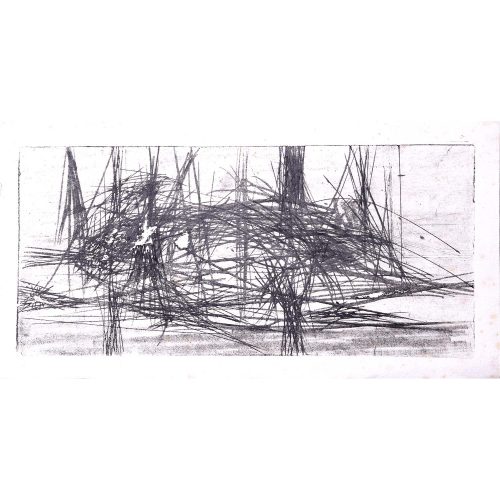
Henry Cliffe (1919-1983) Reclining Figure III
Etching Mid 20th Century 11x24cm Click here for biographical details and other pictures by the artist. If you are interested email info@manningfineart.co.uk or call us on 07929 749056. Condition: Good. -

Henry Cliffe (1919-1983) Reclining Figure IV
Etching Mid 20th Century 11x24cm Click here for biographical details and other pictures by the artist. If you are interested email info@manningfineart.co.uk or call us on 07929 749056. Condition: Good. -
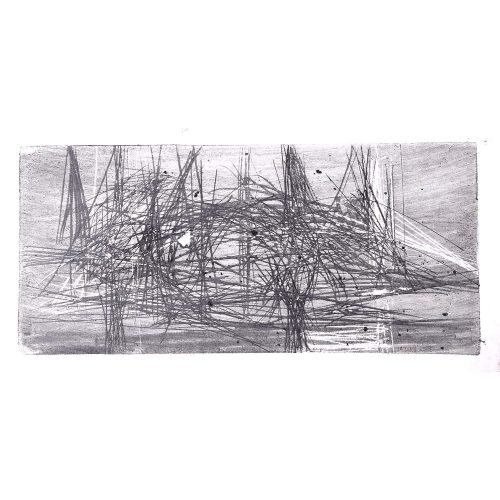
Henry Cliffe (1919-1983) Reclining Figure V
Etching Mid 20th Century 11x24cm Click here for biographical details and other pictures by the artist. If you are interested email info@manningfineart.co.uk or call us on 07929 749056. Condition: Good. -
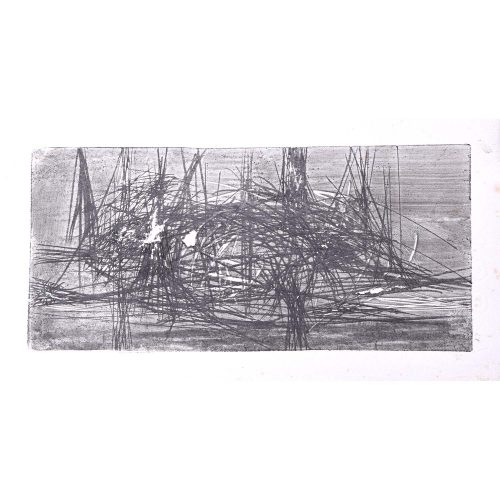
Henry Cliffe (1919-1983) Reclining Figure VI
Etching Mid 20th Century 11x24cm Click here for biographical details and other pictures by the artist. If you are interested email info@manningfineart.co.uk or call us on 07929 749056. Condition: Good. -
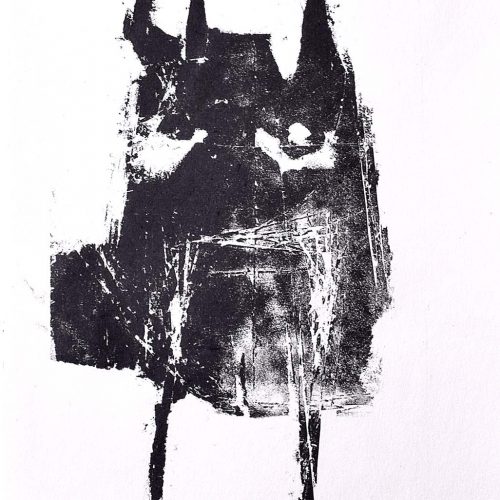
Henry Cliffe (1919-1983) Standing Nude
Etching Mid 20th Century 23x15cm Click here for biographical details and other pictures by the artist. If you are interested email info@manningfineart.co.uk or call us on 07929 749056. Condition: Good. -

Henry Cliffe (1919-1983) Standing Nude II
Etching Mid 20th Century 23x15cm Click here for biographical details and other pictures by the artist. If you are interested email info@manningfineart.co.uk or call us on 07929 749056. Condition: Good. -
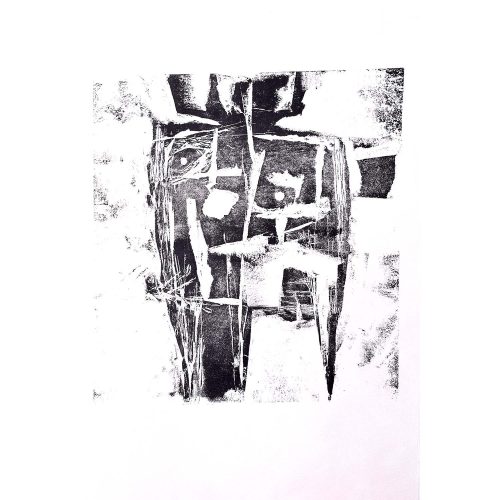
Henry Cliffe (1919-1983) Two Standing Nudes
Etching Mid 20th Century 27x25cm Click here for biographical details and other pictures by the artist. If you are interested email info@manningfineart.co.uk or call us on 07929 749056. Condition: Good. -
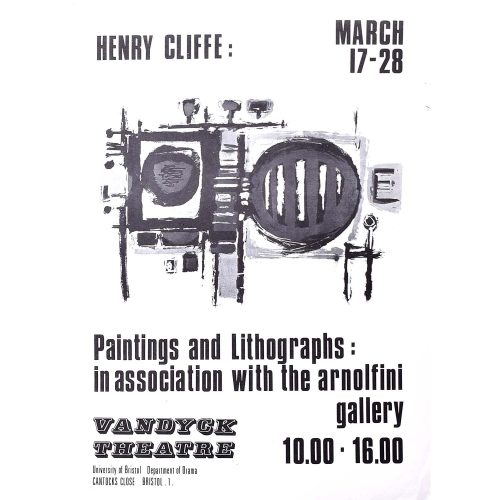
Henry Cliffe (1919-1983) Vandyck Theatre Poster
Etching Mid 20th Century 42x30cm Click here for biographical details and other pictures by the artist. If you are interested email info@manningfineart.co.uk or call us on 07929 749056. Condition: Good. -
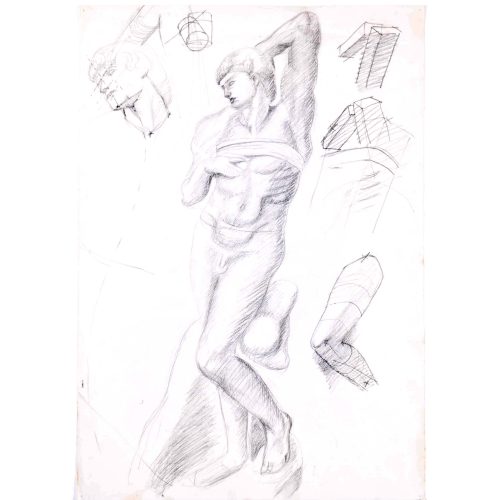
Hilary Hennes (née Hilary Miller) (1919-1993) Sketches of Figures c. 1940
56x39cm Pencil sketch A well-executed sketch. Miller was born in London, where her father was a curator at the South London Art Gallery. She attended Blackheath High School and, from 1936 to 1940, studied at the Blackheath School of Art and then for a further three years at the Royal College of Art. After graduating, Miller taught at the South East Sussex Technical College and in 1946 married the artist Hubert Hennes. The couple set up home in Oxford, where they both held teaching posts at the Oxford School of Art. Between 1948 and 1967 Miller frequently exhibited paintings at the Royal Academy in London and also illustrated a number of books on gardening and natural history, such as The Living World and Boff's Book of Gardening. If you are interested email info@manningfineart.co.uk or call us on 07929 749056. Condition: Generally very good condition, pin holes to corners toning to edge of sheet and occasional soft creases towards edges. -
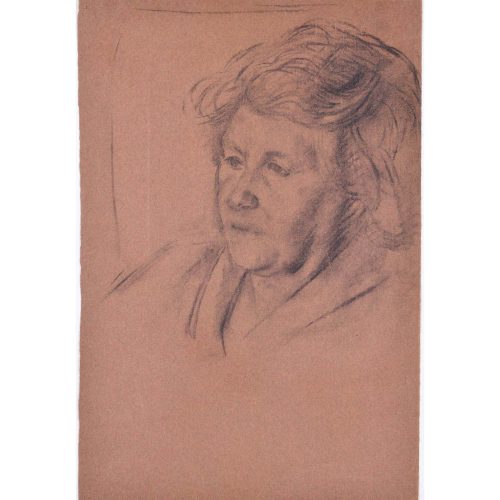
Hilary Hennes (née Hilary Miller) (1919-1993) Sketch of a Woman c. 1940
48x32cm Charcoal A well-executed sketch of a woman's face. Miller was born in London, where her father was a curator at the South London Art Gallery. She attended Blackheath High School and, from 1936 to 1940, studied at the Blackheath School of Art and then for a further three years at the Royal College of Art. After graduating, Miller taught at the South East Sussex Technical College and in 1946 married the artist Hubert Hennes. The couple set up home in Oxford, where they both held teaching posts at the Oxford School of Art. Between 1948 and 1967 Miller frequently exhibited paintings at the Royal Academy in London and also illustrated a number of books on gardening and natural history, such as The Living World and Boff's Book of Gardening. If you are interested email info@manningfineart.co.uk or call us on 07929 749056. Condition: Generally excellent condition, pin holes to corners. -
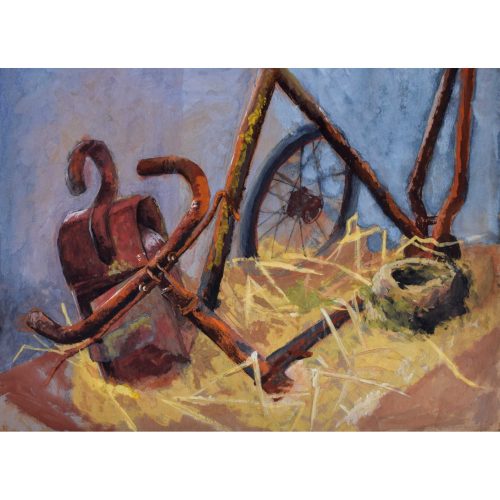
Hilary Hennes (née Hilary Miller) (1919-1993)
The Old Bicycle (c.1940)
46 x 62 cm Gouache on paper Miller was born in London, where her father was a curator at the South London Art Gallery. She attended Blackheath High School and, from 1936 to 1940, studied at the Blackheath School of Art and then for a further three years at the Royal College of Art. After graduating, Miller taught at the South East Sussex Technical College and in 1946 married the artist Hubert Hennes. The couple set up home in Oxford, where they both held teaching posts at the Oxford School of Art. Between 1948 and 1967 Miller frequently exhibited paintings at the Royal Academy in London and also illustrated a number of books on gardening and natural history, such as The Living World and Boff’s Book of Gardening. If you are interested email info@manningfineart.co.uk or call us on 07929 749056 Condition: Good -
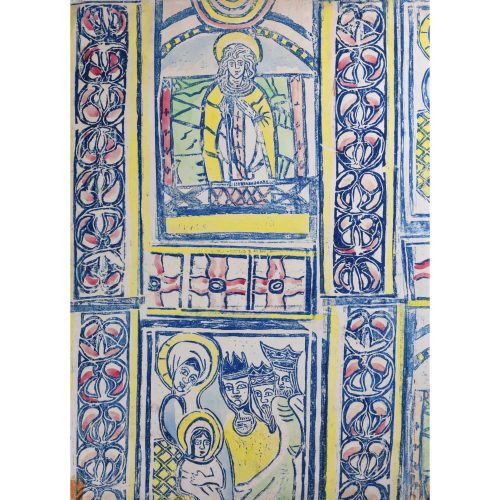
Hilary Hennes (née Hilary Miller) (1919-1993)
Christmas (c.1940)
54 x 74 cm Watercolour over linocut Miller was born in London, where her father was a curator at the South London Art Gallery. She attended Blackheath High School and, from 1936 to 1940, studied at the Blackheath School of Art and then for a further three years at the Royal College of Art. After graduating, Miller taught at the South East Sussex Technical College and in 1946 married the artist Hubert Hennes. The couple set up home in Oxford, where they both held teaching posts at the Oxford School of Art. Between 1948 and 1967 Miller frequently exhibited paintings at the Royal Academy in London and also illustrated a number of books on gardening and natural history, such as The Living World and Boff’s Book of Gardening. If you are interested email info@manningfineart.co.uk or call us on 07929 749056 Condition: Good - some creases. -
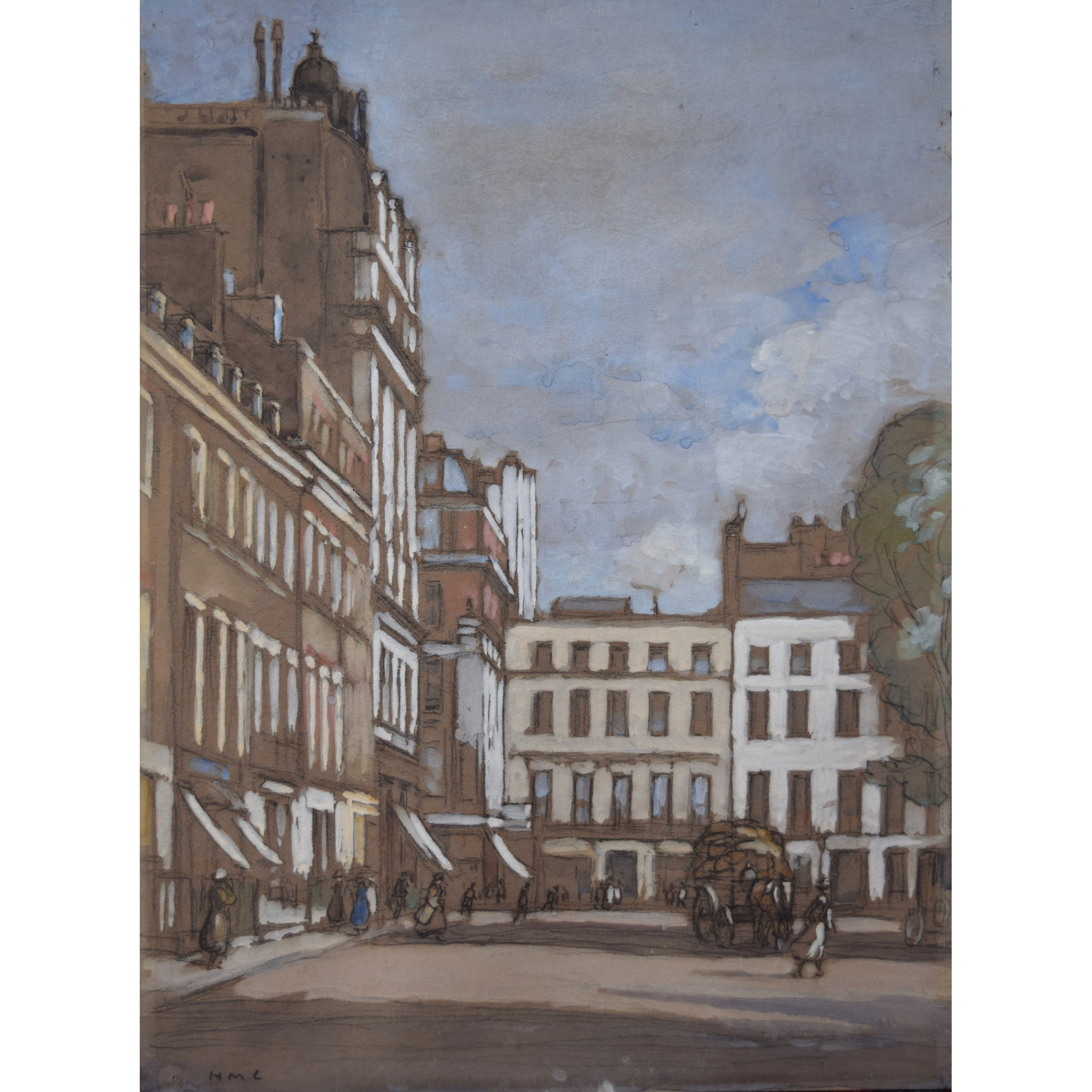
Horace Mann Livens (1862-1936)
Hanover Square London (1920)
Gouache on paper 37x27 cm For biographical details and other works by Livens click here. If you are interested email info@manningfineart.co.uk or call us on 07929 749056. -
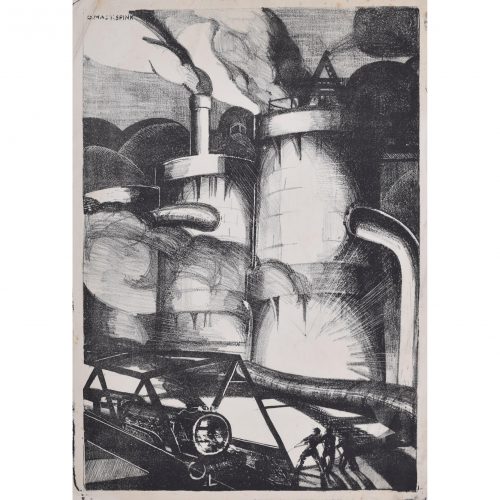
Gerald Mac Spink (flourished 1920 - 1940)
Industrial Scene with Steam Locomotive
Block print 50 x 34 cm Signed 'G Mac Spink' in plate (in reverse) upper left. A beautifully-rendered, almost futurist industrial scene depicting a steam-powered locomotive. The metals of industry dwarf the men working below them, white with heat in chiaroscuro contrast to the dark shadows in the fore- and background of the print. Spink was a skilled artist, illustrator, and designer who produced a series of posters in the inter-war period for companies including the London Underground, Southern Railways, LNER, Hawker Engineering, and British Steel. He won a prize in 1933 from the Imperial Institute for his poster artwork. He also worked as an aeronautical engineer in Kingston-on-Thames for Hawker Engineering; his greatest achievement was the creation of the 'Squanderbug', a 500cc racing car which he built in 1947, and which races even to this day. Provenance: the artist's estate. Condition: generally very good; a few gentle handling creases; three little spots within image. If you are interested, please email info@manningfineart.co.uk or call us on 07929 749056. Click here for other works by the artist. -
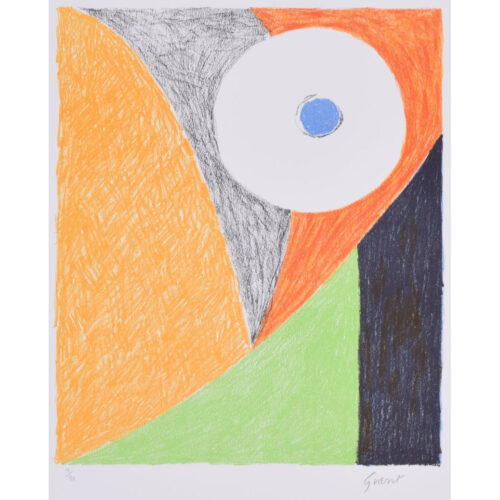
Duncan Grant (1885 - 1978)
Interior (1973)
Lithograph 36 x 30 cm (paper size 77 x 57 cm) Signed 'Grant' and numbered 9/90 in pencil; part of the Penwith Portfolio. Published by Penwith Galleries, St Ives in 1973 with works by Barbara Hepworth, Henry Moore, Peter Lanyon, Alan Davie, Merlyn Evans, John Piper, Ben Nicholson, Robert Adams, Bernard Leach, Michael Rothenstein, and F E McWilliam. An excellent example of Duncan Grant's late work. Duncan Grant was a member of the Bloomsbury Group. He was a painter and also designed textiles, pottery, theatre sets, and costumes. He was a member of the Bloomsbury Group. Condition: generally very good; a few light handling creases in margins. If you are interested, please email info@manningfineart.co.uk or call us on 07929 749056. Click here for more Modern British Art. -
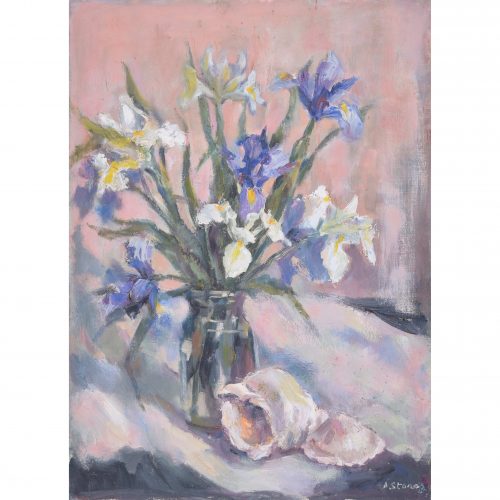
Angela Stones (1914 - 1995)
Irises
Oil on board 56 x 41 cm Signed lower right. A glass jar of irises, with two shells, on a pale pink and peach backdrop. Stones'' impasto technique brings texture to the shells and petals, and shades of purple offset the greens and pinks of the composition. Stones was educated at the Chelsea School of Art, and was a member of an artistic dynasty. Her mother Dorothy Bradshaw (1893-1983) studied under Jack Merriott – the artist famous for his British Rail posters, and her son, Christopher Assheton-Stones (1947-1999), was arguably the foremost pastel artist of his time. Provenance: the family of the artist. Condition: very good. If you’d like to know more, please email info@manningfineart.co.uk or call us on 07929 749056. -
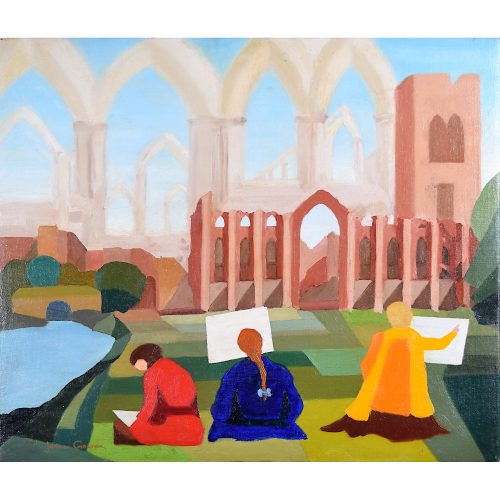
James Gowan (1923, Glasgow - 2015, London) Fountains Abbey (1973)
52x62cm Oil on Canvas Signed 'James Gowan' lower left Inscribed to reverse 'Fountains Abbey 1973 James Gowan No 199' For biographical details and other paintings by Gowan click here. The present work exhibits many of the characteristics obvious in his architectural works. There is a very strong architectural composition. The landscape and sky are approached in almost cubist fashion, reminiscent of the Toblerone-shaped roof of the Leicester Building, whilst the figures have a carefree feel to them. And here indeed are the gothic towers and flying butresses that we know inspired Gowan when designing the Leicester Engineering Building, being captured by the brightly-dressed members of an art class, splashes of primary colour in an already colourful landscape. If you are interested email info@manningfineart.co.uk or call us on 07929 749056. -
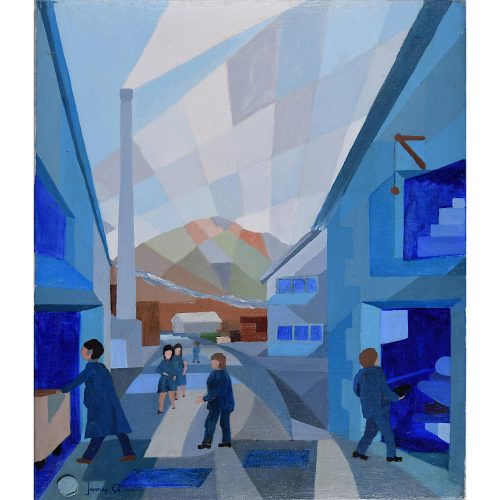
James Gowan (1923, Glasgow - 2015, London) The Blue Mill at Backbarrow
62x52cm Oil on Canvas For biographical details and other paintings by Gowan click here. The present work exhibits many of the characteristics obvious in his architectural works. There is a very strong architectural composition. The landscape and sky are approached in almost cubist fashion, reminiscent of the Toblerone-shaped roof of the Leicester Building, whilst the figures have a carefree feel to them. Backbarrow was the place where the blue pigment ultramarine (or dolly blue - used to return brilliant whiteness to yellowed fabrics) was produced in an old mill building by the Lancashire Ultramarine Company. Dust from the production gave the entire village a blue tint until production ceased in 1981. The factory is now a hotel and it maintains a display of machinery used in the factory. If you are interested email info@manningfineart.co.uk or call us on 07929 749056. -
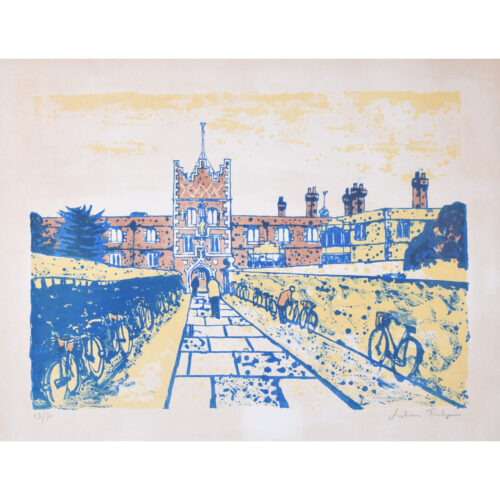
Julian Trevelyan (1910 - 1988)
Jesus College, Cambridge
Lithograph 38 x 53 cm Numbered 13/70 lower left and signed lower right, both in pencil. Nephew of the historian G M Trevelyan, Julian Trevelyan was educated at Bedales and then at Trinity College, Cambridge, where he read English. After moving to Paris, Trevelyan studied engraving at Stanley William Hayter’s school, working alongside artists such as Max Ernst, Joan Miro and Pablo Picasso. He married the potter Ursula Darwin in 1934, and in 1935 they moved to Hammersmith, buying Durham Wharf beside the River Thames which was Trevelyan’s studio – and home – for the rest of his life. His wartime service was – like so many artists – as a camoufleur. A Royal Engineer from 1940-43, he served in North Africa and Palestine, forcing the German Afrika Korps to use resources against a dummy army whilst real tanks were disguised as more harmless equipment. In the desert, nothing could be hidden - but it could be disguised. Following the dissolution of his marriage in 1950, he married the painter Mary Fedden. Teaching at Chelsea School of Art, Trevelyan eventually became head of the Etching Department and his pupils included David Hockney and Peter Ackroyd. Condition: generally very good; some age toning to paper. If you are interested, please email info@manningfineart.co.uk or call us on 07929 749056. Click here for other views of Jesus College, Cambridge. -
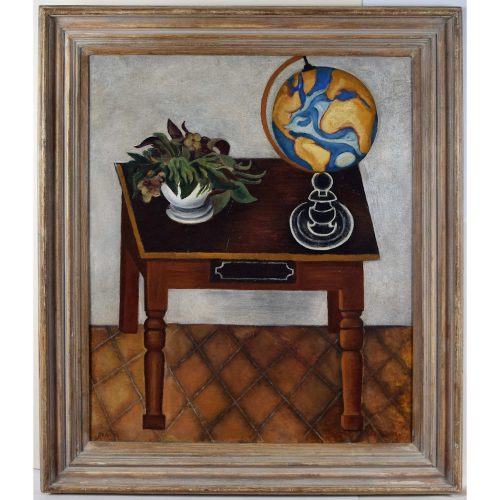
John Aldridge RA (1905 - 1983)
Still Life Painted at El Porche, Deja, Majorca 1932
Oil on Board 74 x 62 cm Signed ‘John Aldridge’ lower right and titled to reverse. Aldridge read Greats at Corpus Christi College, Oxford, and then moved to London in 1928 and taught himself to paint. From 1931 to 1933 he exhibited with the Seven and Five Society at the Leicester Galleries and in 1934 he exhibited at the Venice Biennale. At this time he began his life-long association with the poet Robert Graves and the poets and artists who centred themselves on him in the village of Deia in Majorca. In 1933 he moved to Place House in Great Bardfield with his cats. He became a friend of his neighbour Edward Bawden, and the two collaborated during the 1930s on Bardfield wallpapers, distributed by Cole & Sons. During the War, Aldridge served in the Intelligence Corps, interpreting aerial photographs. Following the war he returned to Great Bardfield and painted scenes of the Essex countryside, and also of Majorca. By this period, his early association with the avant garde of British art had been lost; today, his rural scenes are very popular but arguably lack the complexity of his earlier works, such as this contemplative still life. His art is in major public collections such as the Tate, the British Council, the National Portrait Gallery, the Royal Academy and the Victoria and Albert Museum. The Fry Art Gallery in Saffron Walden, which specialises in East Anglian pictures, has a significant holding of his work. Condition: generally very good. Distressed frame with occasional loss, and hardboard substrate bowed. -

John Piper (1903-1992)
Bullslaughter Bay
Watercolour, gouache and pastel on paper 27.5 x 35.5cm John Piper CH was an English painter, printmaker, and designer of stained-glass windows. His work often focused on the British landscape, especially churches and monuments, and included tapestry designs, book jackets, screen-prints, photography, fabrics and ceramics. Piper spent a considerable amount of time in Pembrokeshire, frequently returning to the landscape of Bullslaughter Bay; this painting was probably produced there in the mid-1950s. The artist captures an animated, capricious bay, characterised by a distinctive colour palette and stamped with irregular rock formations. Condition: generally excellent. For other works by the artist and biographical details, click here. If you are interested email info@manningfineart.co.uk or call us on 07929 749056. -

John Piper (1903-1992)
Capesthorne Hall (1977)
Screenprint 64 x 102 cm Piper captures here, in his usual fanciful colours, the Cheshire stately home of Capesthorne Hall. Built in neoclassical style by William Smith and his son Francis, the hall today is used for weddings and other civil occasions. John Piper CH was an English painter, printmaker, and designer of stained-glass windows. His work often focused on the British landscape, especially churches and monuments, and included tapestry designs, book jackets, screen-prints, photography, fabrics and ceramics. Condition: very good; a little old discolouration to edges under mount. If you are interested, please email info@manningfineart.co.uk or call us on 07929 749056. Click here for other works by John Piper. -
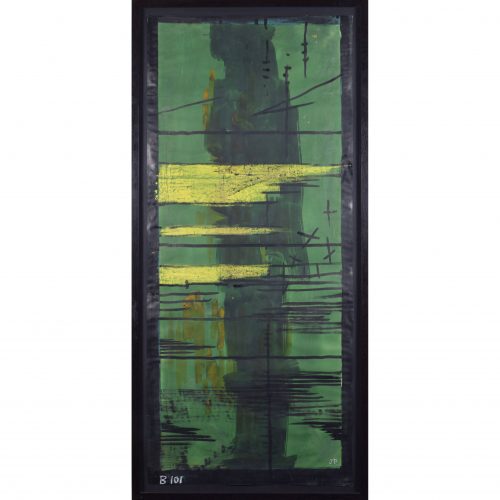
John Piper (1903 - 1992)
Cartoon for Baptistry Chapel Window, Coventry Cathedral
Gouache and mixed media art 127 x 54 cm Labelled B101 by the artist and initialled. A gouache design for one of the Coventry Cathedral Baptistry Window panels. John Piper was commissioned to design the Baptistry Window in 1955, in partnership with glassmaker Patrick Reyntiens. The window is made of 198 panels of stained glass and is 26 metres high.Piper commented in his book “Stained Glass: Art or Anti-Art?” that ‘The function, the flesh and blood and bones of stained glass – its whole being – is to gratify light and to intensify atmosphere in a room or building, not necessarily to provide colour – or a message.’ The ambiguous post-war tenor of the design is striking: the khaki palette, the soldier-like figure, and the landscape evoking a 20th century theatre of war.
John Piper CH was an English painter, printmaker, and designer of stained-glass windows. His work often focused on the British landscape, especially churches and monuments, and included tapestry designs, book jackets, screen-prints, photography, fabrics and ceramics. Condition: very good. Four pin holes and a small handling mark mid left. If you are interested, please email info@manningfineart.co.uk or call us on 07929 749056. Click here for other works by John Piper. -
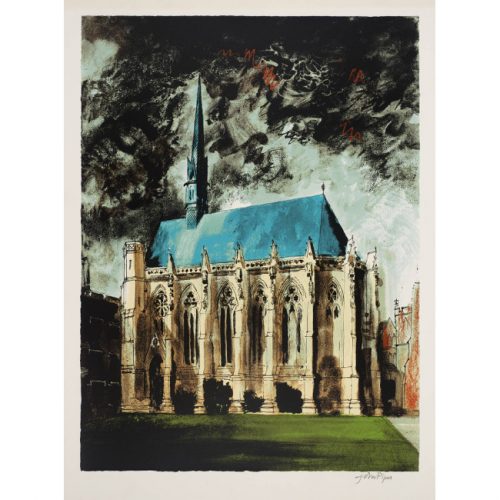
John Piper (1903–1992)
Exeter College, Oxford (1977)
Screenprint Signed in pencil 81.9x61cm (32.2x24 inches) One of Piper's largest and most impressive prints, here featuring Gilbert Scott's chapel at Exeter. It is often claimed that Gilbert Scott based it on Paris's Sainte Chapelle. If you are interested email info@manningfineart.co.uk or call us on 07929 749056. Condition: slight even age toning to paper, small area of repair to print. -
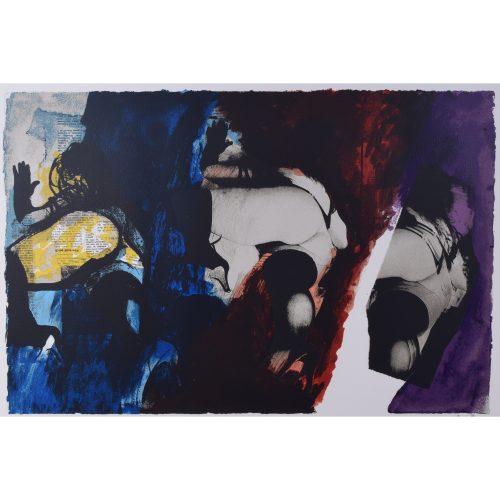
John Piper C.H. (British 1903-1992)
Eye and Camera: Red, Blue and Yellow
(Levinson 317) Screenprint in colours, 1980, on Arches signed John Piper, a proof print aside form the numbered edition of 150, published by Kelpra Editions and the Tate Gallery. Framed in plain black hand-finished frame 400 x 605 mm Condition: Excellent - never previously framed. Click here for biographical details and other works by the artist. If you are interested email info@manningfineart.co.uk or call us on 07929 749056. -
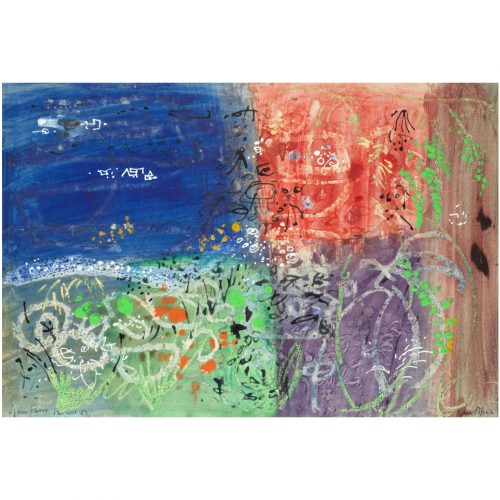
John Piper C.H. (1903-1992)
Garn Fawr
Watercolour and gouache on paper; executed 1969 37 x 54 cm Titled and dated lower left ‘Garn Fawr 12 VIII 69′; signed lower right. It was Piper's wife, Myfanwy - whom he met whilst she lived in London with her Welsh family - who first introduced Piper to West Wales in the 1930s. The Pembrokeshire landscape became his muse, as it also did for Graham Sutherland, another great neo-romantic painter. Having lived in various parts of Wales during the post-war period, the Pipers bought a cottage by Garn Fawr, on the Pembrokeshire Coas, in 1962. The volcanic outcrop was the site of an Iron Age hill fort, and had also been used as a high-viewpoint during the First World War. Piper started out as a mostly abstract artist, but by the 1960s he had moved more towards realism, often focusing on depicting architecture. Here, Piper paints the wet Welsh countryside. Each of the fields is complete with its own crop; the different plants and flowers are designated by characteristic splashes of dark colour. For other works by the artist and biographical details, click here. If you are interested, please email info@manningfineart.co.uk or call us on 07929 749056. -
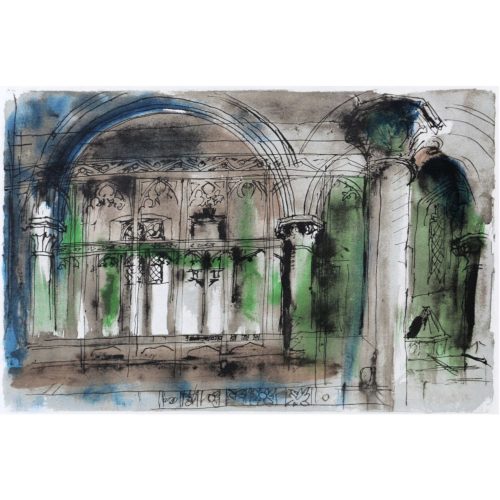
John Piper (1903 - 1992)
Inglesham Church (1989)
Lithograph 38 x 56 cm Piper’s rendering of St John the Baptist Church, Inglesham. His characteristic markmaking, with hues of blue and green, makes up the architecture of the interior. John Piper CH was an English painter, printmaker, and designer of stained-glass windows. His work often focused on the British landscape, especially churches and monuments, and included tapestry designs, book jackets, screen-prints, photography, fabrics and ceramics. Condition: very good. If you are interested, please email info@manningfineart.co.uk or call us on 07929 749056. Click here for other works by John Piper. -
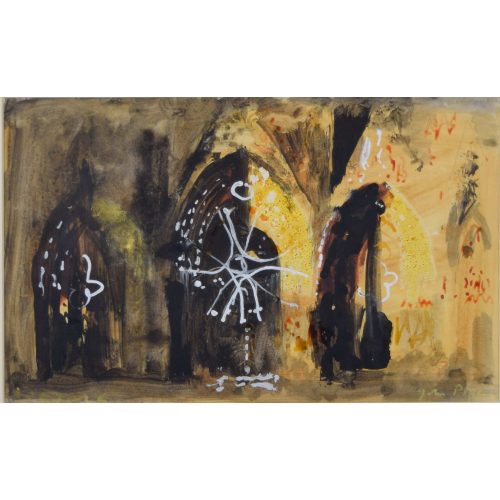
John Piper (1903-1992)
Reims Cathedral (c. 1960)
Ink, watercolour and gouache 21x35cm Inscribed 'Reims' lower left and signed 'John Piper' lower right. Piper loved all things France, and all things Cathedral; in this work, he brings the cathedral of Reims, where France's monarchs were crowned, to life. Piper also produced an aquatint of Reims which was published in 1972. For other works by the artist and biographical details, click here. If you are interested email info@manningfineart.co.uk or call us on 07929 749056. Condition: Generally excellent; framed. -
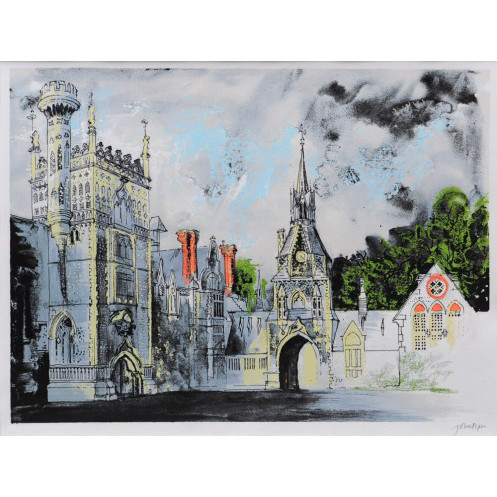
John Piper C.H. (BRITISH, 1903-1992)
Shadwell Park
(Levinson 277) Screenprint in colours, on Arches, signed and numbered. Printed by Kelpra Studio and published by Marlborough Fine Art, London. 510 x 690mm From the 'Victorian Dream Palaces' series of prints by Piper. Click here for biographical details and other works by the artist. If you are interested email info@manningfineart.co.uk or call us on 07929 749056. Condition: generally very good. A little discolouration to extreme margins hidden under mount. In hand-finished black-painted frame. -
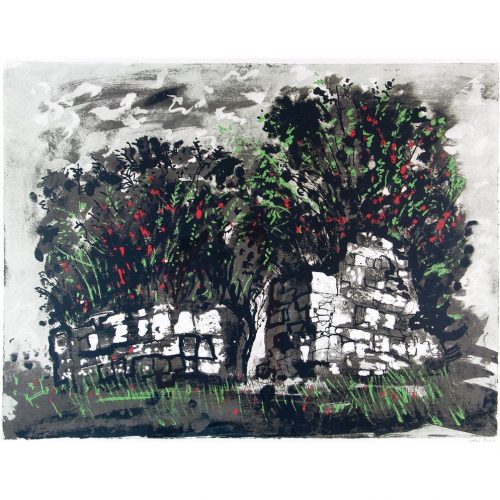
John Piper
Skeabost, Skye 1975
Screenprint by Curwen Studio Printed on Arches by Kelpra Studio and published by Marlborough Fine Art 68x89cm Signed in crayon; an un-numbered proof print aside from the edition of 70. Levinson 250 From the Series 'Five Scottish Chapels (in ruins)' If you are interested email info@manningfineart.co.uk or call us on 07929 749056. -
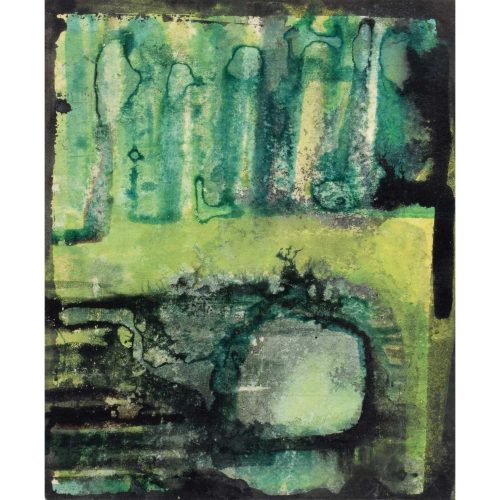
John Piper (1903-1992)
Study for the Piper Building mural
Gouache 14.5x11.5cm Provenance: P Manzareli (who built the fibreglass murals for Piper), gift from the artist; Milne & Moller Fine Art; Katharine House Gallery; private collection, Scotland. This study is a fascinating part of London's architectural history. The Piper Building is a mid-century architectural icon in Fulham. Built in the 1950s as 'Watson House', it was a laboratory complex for the North Thames Gas Board and has an innovative concrete structure. Piper was commissioned to produce the murals surrounding the building. The Gas Board moved out in the mid 1980s. Scheduled for demolition in the 1990s, the building was instead converted into seventy apartments and renamed the Piper Building. With double-height ceilings, the apartments were sold as shells, and purchasers were free to commission their own architects and builders. Condition: Generally excellent; framed. For other works by the artist and biographical details, click here. If you are interested email info@manningfineart.co.uk or call us on 07929 749056. -
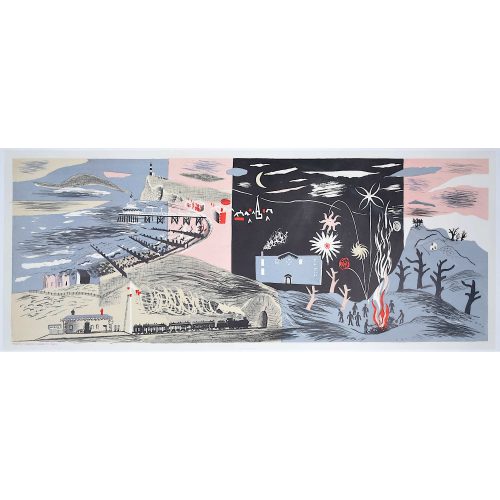
John Piper C.H. (British 1903-1992) Nursery Frieze II
500 x 1250 mm Lithograph 1936 One of Piper's many seascapes, Frieze II is an exercise in abstract capriccio. Piper draws together the muted grey, pink, and blue of the lithograph's fragmented background with foreground details in black, white, and bright red, picking out particular moments of the frieze for the viewer. The lighthouse has no keeper; the beach and the pier are empty; the train has neither passengers nor driver. The church at the top of the rocky hill is a brilliant cubist borrowing, showing both the West end and the North side simultaneously - and it has no congregation. The only human figures present in the frieze are those collected around the bonfire, watching the flames and the show of fireworks. The scene is at once devoid of people and intensely human. Piper was just 24 when he made Frieze II. If you are interested, please email info@manningfineart.co.uk or call us on 07929 749056. Condition: Generally very good, backed to linen with small - and largely not visible - areas of restoration. -
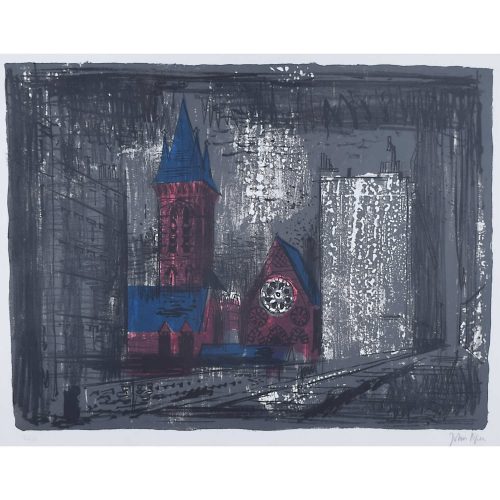
John Piper (1903-1992)
St James the Less, Westminster
Screenprint 65 x 49 cm From the 'Retrospect of Churches' series, numbered 24/70. Generally very good. Signed in pencil. John Piper CH was an English painter, printmaker, and designer of stained-glass windows. His work often focused on the British landscape, especially churches and monuments, and included tapestry designs, book jackets, screen-prints, photography, fabrics and ceramics. A Retrospect of Churches was issued as a suite of 24 original colour lithographs in colour, in an edition of 70 copies (70 numbered copies plus five artist's proofs). This poignant and dramatic representation of St James the Less is an evocative depiction of this part of London in the evening: wet pavements reflect the bright lights of the buildings, and the church is a warm, moody reddish-purple against the deep black of a dark night. Condition: Generally very good. -
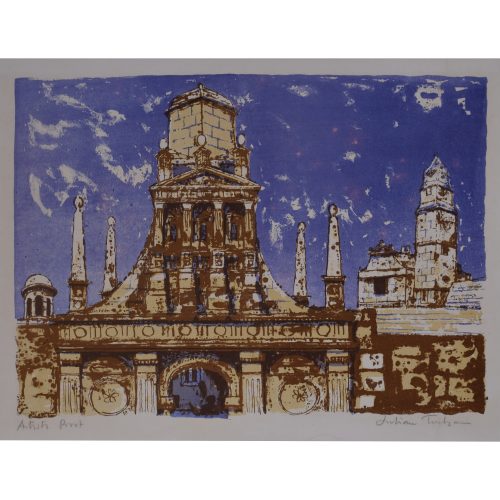
Julian Otto Trevelyan, RA (1910 -1988) Caius College II, Cambridge (1959/1962)
Signed by the artist and inscribed in pencil Artist's Proof, aside from the edition of 70. The edition consisted of 70 numbered proofs and 30 artist’s proofs. We also have listed one of the 70 numbered proof prints, which is in a purple colourway - rather than the blue here. 37x51cm (14.5×20 inches) This comes from Julian Trevelyan’s Cambridge Suite which consisted of 10 lithographs: Caius College, Caius College II, Christ’s College, Corpus Christi College, Downing College, Emmanuel College, Jesus College, Peterhouse, St Catharine’s College and Sidney Sussex College. The Government Art Collection has copies of several of the prints in this series. If you are interested email info@manningfineart.co.uk or call us on 07929 749056. Condition: Good. Old crease that runs from top to bottom has been restored and is barely perceptible - see photograph. -
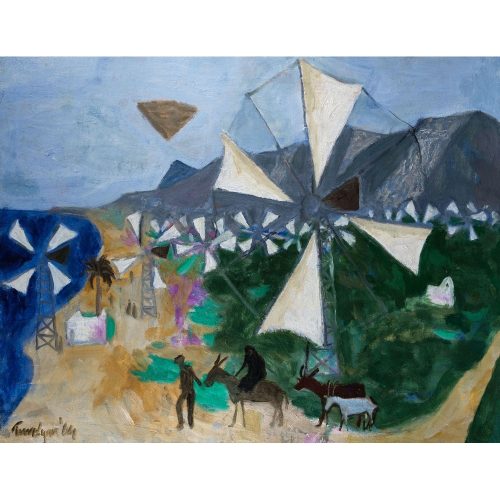
Julian Trevelyan (1910-1988)
Cretan Windmills (1964)
Oil on canvas 61 x 77 cm Peasants and a donkey, followed by a cow and goat, travel along the Cretan shore. Windmills dominate the shoreline - Julian Trevelyan was markedly inspired by the windmills he saw while visiting Crete in the 1960s. The composition is substantially made up of triangular forms; the inverted floating pyramid hovers above the flashing blades of the windmills. Combined with the man, woman, and donkey in the foreground, the pyramid detail suggests Mary and Joseph’s Flight into Egypt. Click here for biographical details and other works by the artist. If you are interested email info@manningfineart.co.uk or call us on 07929 749056. -

Julian Trevelyan (1910-1988)
Father Thames (1969)
Etching and aquatint, signed, numbered 53/75 35x48cm Click here for biographical details and other works by the artist. If you are interested email info@manningfineart.co.uk or call us on 07929 749056. -
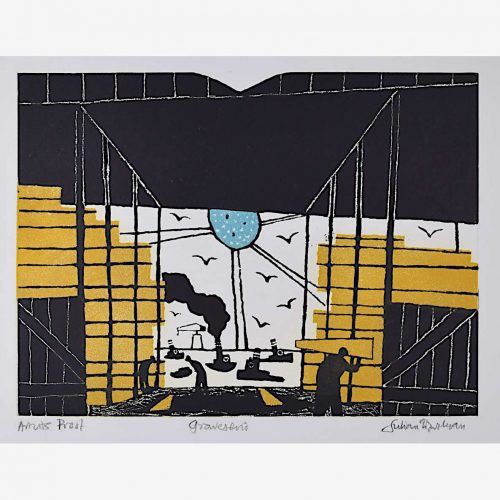
Julian Trevelyan (1910-1988)
Gravesend (1969)
Etching and aquatint, signed, titled, and inscribed 'Artist's Proof' in pencil 35x48cm (sheet size 59x77cm) On J Green paper Condition: generally excellent, never previously framed, see image. Click here for biographical details and other works by the artist. If you are interested email info@manningfineart.co.uk or call us on 07929 749056. -

Julian Trevelyan (1910-1988)
Kensington Gardens (1969)
Etching and aquatint, signed, numbered 55/75 35x48cm Click here for biographical details and other works by the artist. If you are interested email info@manningfineart.co.uk or call us on 07929 749056. -

Julian Trevelyan (1910-1988)
New York Bridges (1982)
Oil on canvas 76 x 61 cm (29.9 x 24 in.) In artist's original wooden frame. Provenance: the estate of Mary Fedden from the estate of her husband Julian Trevelyan. Click here for biographical details and other works by the artist. If you are interested email info@manningfineart.co.uk or call us on 07929 749056. -

Julian Trevelyan (1910-1988)
Richmond (1969)
Etching and aquatint, signed, numbered 47/75 48x35cm Click here for biographical details and other works by the artist. If you are interested email info@manningfineart.co.uk or call us on 07929 749056. -
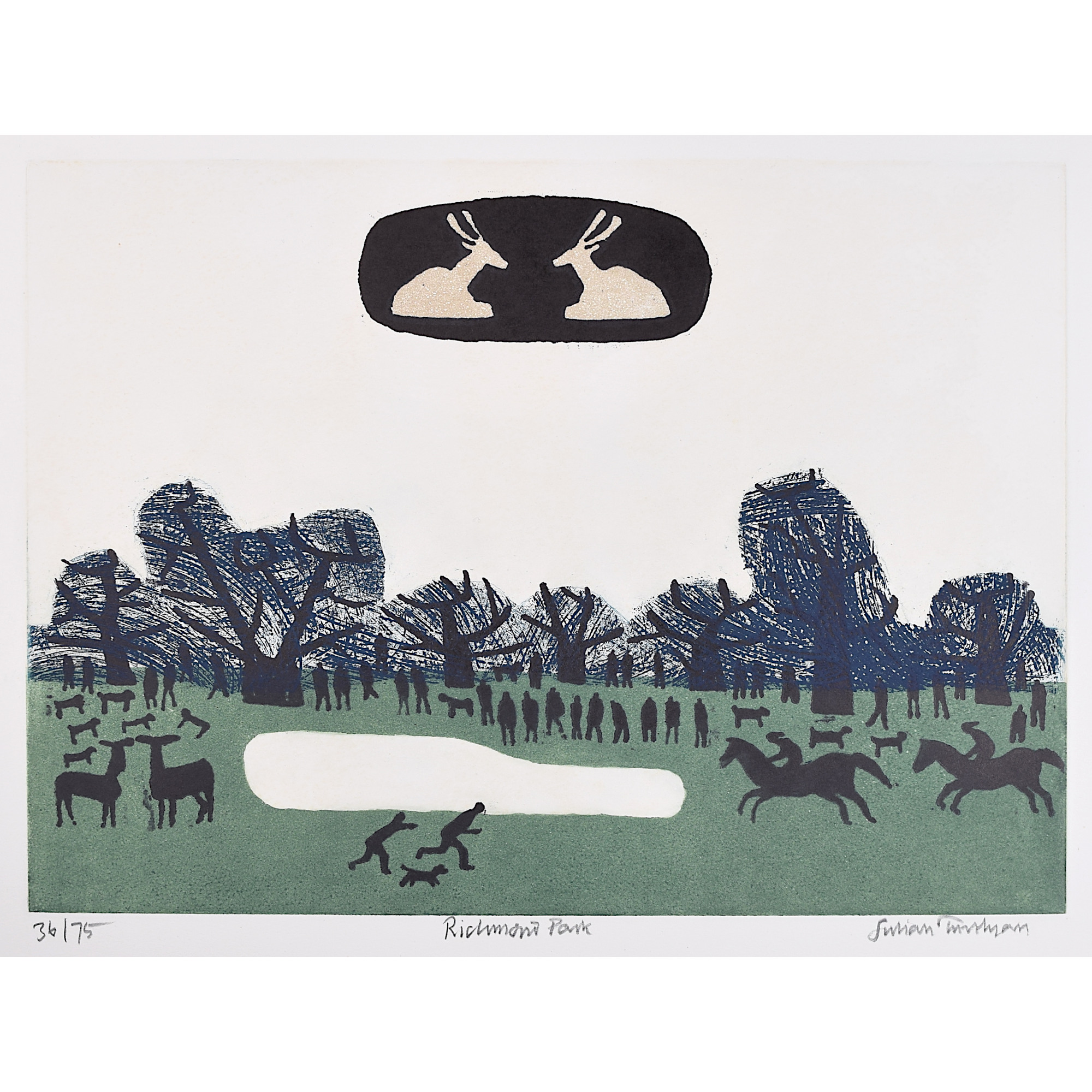
Julian Trevelyan (1910-1988)
Richmond Park (1969)
Etching and aquatint, Signed, numbered 36/75 35x48cm (sheet size 59x77cm) On J Green paper from the Thames Suite Click here for biographical details and other works by the artist including several others from the Thames Suite. If you are interested email info@manningfineart.co.uk or call us on 07929 749056. -

Julian Trevelyan (1910-1988)
St James' Park (1969-70)
Etching and aquatint, signed, numbered 48/75 35x48cm Click here for biographical details and other works by the artist. If you are interested email info@manningfineart.co.uk or call us on 07929 749056. -
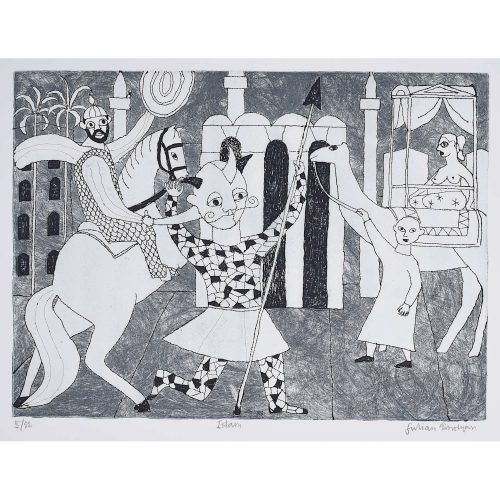 Julian Trevelyan (1910-1988) Islam Etching 35 x 48 cm (sheet size 55 x 68 cm) Nephew of the historian G M Trevelyan, Julian Trevelyan was educated at Bedales and then at Trinity College, Cambridge, where he read English. After moving to Paris, Trevelyan studied engraving at Stanley William Hayter’s school, working alongside artists such as Max Ernst, Joan Miro and Pablo Picasso. He married the potter Ursula Darwin in 1934, and in 1935 they moved to Hammersmith, buying Durham Wharf beside the River Thames which was Trevelyan’s studio – and home – for the rest of his life. His wartime service was – like so many artists – as a camoufleur. A Royal Engineer from 1940-43, he served in North Africa and Palestine, forcing the German Afrika Korps to use resources against a dummy army whilst real tanks were disguised as more harmless equipment. In the desert, nothing could be hidden - but it could be disguised. Following the dissolution of his marriage in 1950, he married the painter Mary Fedden. Teaching at Chelsea School of Art, Trevelyan eventually became head of the Etching Department and his pupils included David Hockney and Peter Ackroyd. Condition: mounted to board.
Julian Trevelyan (1910-1988) Islam Etching 35 x 48 cm (sheet size 55 x 68 cm) Nephew of the historian G M Trevelyan, Julian Trevelyan was educated at Bedales and then at Trinity College, Cambridge, where he read English. After moving to Paris, Trevelyan studied engraving at Stanley William Hayter’s school, working alongside artists such as Max Ernst, Joan Miro and Pablo Picasso. He married the potter Ursula Darwin in 1934, and in 1935 they moved to Hammersmith, buying Durham Wharf beside the River Thames which was Trevelyan’s studio – and home – for the rest of his life. His wartime service was – like so many artists – as a camoufleur. A Royal Engineer from 1940-43, he served in North Africa and Palestine, forcing the German Afrika Korps to use resources against a dummy army whilst real tanks were disguised as more harmless equipment. In the desert, nothing could be hidden - but it could be disguised. Following the dissolution of his marriage in 1950, he married the painter Mary Fedden. Teaching at Chelsea School of Art, Trevelyan eventually became head of the Etching Department and his pupils included David Hockney and Peter Ackroyd. Condition: mounted to board. -
Out of stock
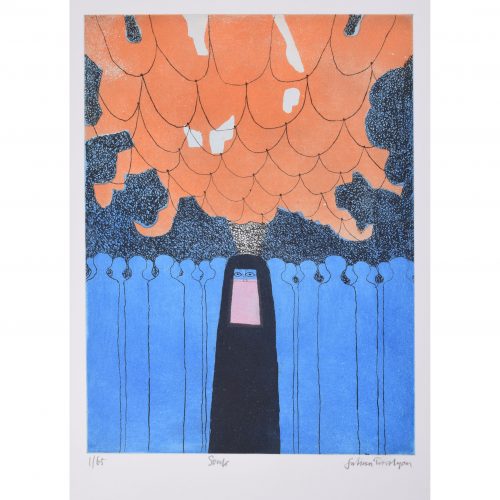
Julian Trevelyan (1910 - 1988)
Souk (1972)
Etching and aquatint 71 x 56 cm Signed, titled, and numbered 1/65 in pencil outside of the plate. The Tate Collection holds number 25/65. An Arab bazaar. Tall, nameless blue figures surround a veiled and staring woman. Nephew of the historian G M Trevelyan, Julian Trevelyan was educated at Bedales and then at Trinity College, Cambridge, where he read English. After moving to Paris, Trevelyan studied engraving at Stanley William Hayter’s school, working alongside artists such as Max Ernst, Joan Miro and Pablo Picasso. He married the potter Ursula Darwin in 1934, and in 1935 they moved to Hammersmith, buying Durham Wharf beside the River Thames which was Trevelyan’s studio – and home – for the rest of his life. His wartime service was – like so many artists – as a camoufleur. A Royal Engineer from 1940-43, he served in North Africa and Palestine, forcing the German Afrika Korps to use resources against a dummy army whilst real tanks were disguised as more harmless equipment. In the desert, nothing could be hidden - but it could be disguised. Following the dissolution of his marriage in 1950, he married the painter Mary Fedden. Teaching at Chelsea School of Art, Trevelyan eventually became head of the Etching Department and his pupils included David Hockney and Peter Ackroyd. Condition: mounted to board, small scuff to very bottom of margin, otherwise very good. If you’d like to know more, please email info@manningfineart.co.uk or call us on 07929 749056. -
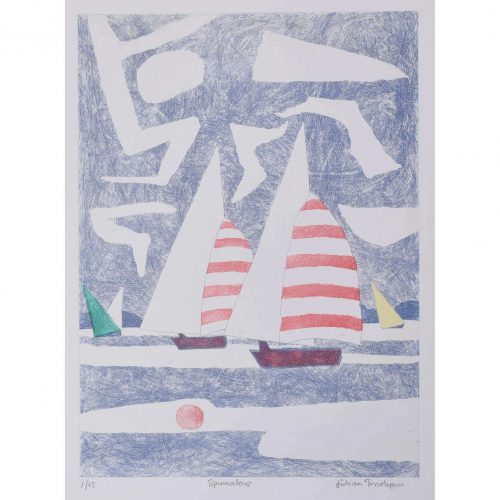
Julian Trevelyan (1910-1988)
Spinnakers (1972)
Etching 48 x 35 cm (sheet size 68 x 55 cm) Signed in pencil and numbered 1/65. The Tate holds number 24/56 - reference P01330. Small vessels weave around two great boats with striped masts, observed by a dark sky full of geometric clouds. A red buoy bobs in the foreground, and the heavily textured sea and sky blend into one. Nephew of the historian G M Trevelyan, Julian Trevelyan was educated at Bedales and then at Trinity College, Cambridge, where he read English. After moving to Paris, Trevelyan studied engraving at Stanley William Hayter’s school, working alongside artists such as Max Ernst, Joan Miro and Pablo Picasso. He married the potter Ursula Darwin in 1934, and in 1935 they moved to Hammersmith, buying Durham Wharf beside the River Thames which was Trevelyan’s studio – and home – for the rest of his life. His wartime service was – like so many artists – as a camoufleur. A Royal Engineer from 1940-43, he served in North Africa and Palestine, forcing the German Afrika Korps to use resources against a dummy army whilst real tanks were disguised as more harmless equipment. In the desert, nothing could be hidden - but it could be disguised. Following the dissolution of his marriage in 1950, he married the painter Mary Fedden. Teaching at Chelsea School of Art, Trevelyan eventually became head of the Etching Department and his pupils included David Hockney and Peter Ackroyd. Condition: generally very good. Mounted to board. If you’d like to know more, please email info@manningfineart.co.uk or call us on 07929 749056. -
Out of stock
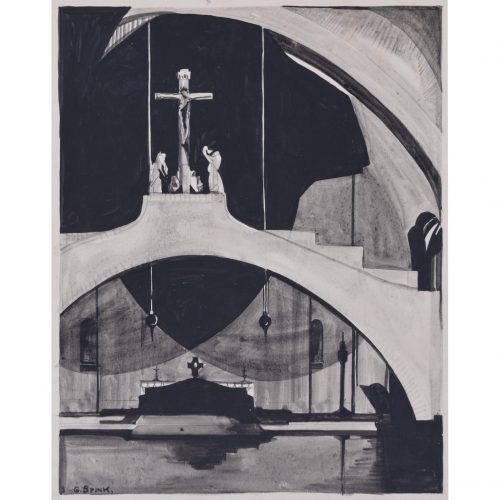
Gerald Mac Spink (flourished 1920 - 1940)
Kelham Hall Chapel I
Watercolour 29 x 24 cm Signed 'G Spink' lower left. A depiction of the magnificent chapel at Kelham Hall, a sumptuous Gothic Revival Victorian country house designed by George Gilbert Scott. The artist highlights the soaring, cavernous proportions of the chapel and the delicate beauty of its focal point: a raised crucifix which also acts as an altar screen. There have been three halls at Kelham over the centuries, all built by the Manners Sutton family, whose links with Nottinghamshire go back to the 12th century. The first Kelham Hall was built shortly after the end of the Civil War for Robert Sutton, 1st Lord Lexington. It was destroyed by fire in 1728 and rebuilt for Bridget, the Duchess of Rutland, the daughter of the 2nd Lord Lexington. Bridget Sutton had married John Manners, the 3rd Duke of Rutland. Today's Kelham Hall was built by the revered Victorian architect Sir George Gilbert Scott after the second Hall was destroyed by fire in 1857. Between 1903 and 1973 the hall was used an Anglican theological college for the Society of the Sacred Mission, which built the domed chapel in 1928. The Hall is now a sought-after wedding venue. Spink was a skilled artist, illustrator, and designer who produced a series of posters in the inter-war period for companies including the London Underground, Southern Railways, LNER, Hawker Engineering, and British Steel. He won a prize in 1933 from the Imperial Institute for his poster artwork. He also worked as an aeronautical engineer in Kingston-on-Thames for Hawker Engineering; his greatest achievement was the creation of the 'Squanderbug', a 500cc racing car which he built in 1947, and which races even to this day. Provenance: the artist's estate. Condition: very good. If you are interested, please email info@manningfineart.co.uk or call us on 07929 749056. Click here for other architectural views. -
Out of stock
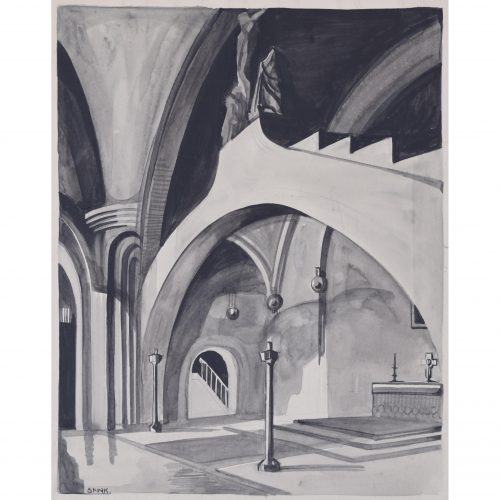
Gerald Mac Spink (flourished 1920 - 1940)
Kelham Hall Chapel II
Watercolour 29 x 24 cm Signed 'G Spink' lower left. A depiction of the magnificent chapel at Kelham Hall, a sumptuous Gothic Revival Victorian country house designed by George Gilbert Scott. The artist highlights the soaring, cavernous proportions of the chapel and the delicate beauty of its focal point: a raised crucifix which also acts as an altar screen. There have been three halls at Kelham over the centuries, all built by the Manners Sutton family, whose links with Nottinghamshire go back to the 12th century. The first Kelham Hall was built shortly after the end of the Civil War for Robert Sutton, 1st Lord Lexington. It was destroyed by fire in 1728 and rebuilt for Bridget, the Duchess of Rutland, the daughter of the 2nd Lord Lexington. Bridget Sutton had married John Manners, the 3rd Duke of Rutland. Today's Kelham Hall was built by the revered Victorian architect Sir George Gilbert Scott after the second Hall was destroyed by fire in 1857. Between 1903 and 1973 the hall was used an Anglican theological college for the Society of the Sacred Mission, which built the domed chapel in 1928. The Hall is now a sought-after wedding venue. Spink was a skilled artist, illustrator, and designer who produced a series of posters in the inter-war period for companies including the London Underground, Southern Railways, LNER, Hawker Engineering, and British Steel. He won a prize in 1933 from the Imperial Institute for his poster artwork. He also worked as an aeronautical engineer in Kingston-on-Thames for Hawker Engineering; his greatest achievement was the creation of the 'Squanderbug', a 500cc racing car which he built in 1947, and which races even to this day. Provenance: the artist's estate. Condition: very good. If you are interested, please email info@manningfineart.co.uk or call us on 07929 749056. Click here for other architectural views. -
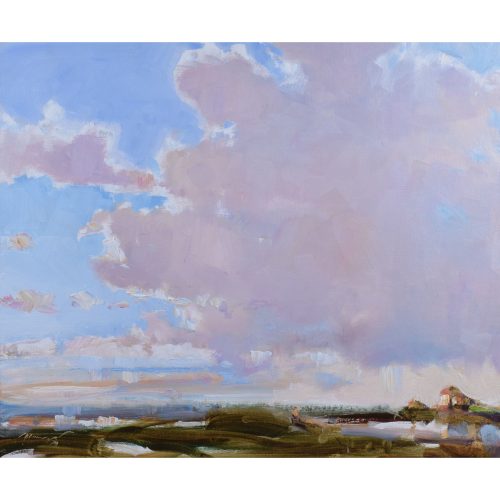
Ken Moroney (British, 1948-) The Fens, Norfolk (c. 1990)
Oil on canvas board 48 x 58 cm Provenance: Bonhams (2003) Of Anglo-Irish parentage, Moroney was born in South London, and showed early artistic talent. His Irish father, finding it unmanly, encouraged him to box, and whilst a teenager Moroney won a gold medal. However this did not distract him from art, and once his boxing hobby came to an end the paints continued to show his flair. Self-taught, his impressionistic style, with bold use of colour, has found widespread favour and his works now hang in many important collections. Here he captures the many colours often visible in a fenland sky, where the flat landscape makes for huge skies. If you are interested email info@manningfineart.co.uk or call us on 07929 749056. Condition: Excellent.


